Preparation of Accounting Records using Spreadsheets
VerifiedAdded on 2023/01/09
|31
|4903
|93
AI Summary
This document provides a detailed explanation of how to prepare accounting records using spreadsheets. It includes journal entries, T-accounts, unadjusted trial balance, types of adjusting entries, and a ten-column worksheet. The content is relevant to accounting and finance courses.
Contribute Materials
Your contribution can guide someone’s learning journey. Share your
documents today.
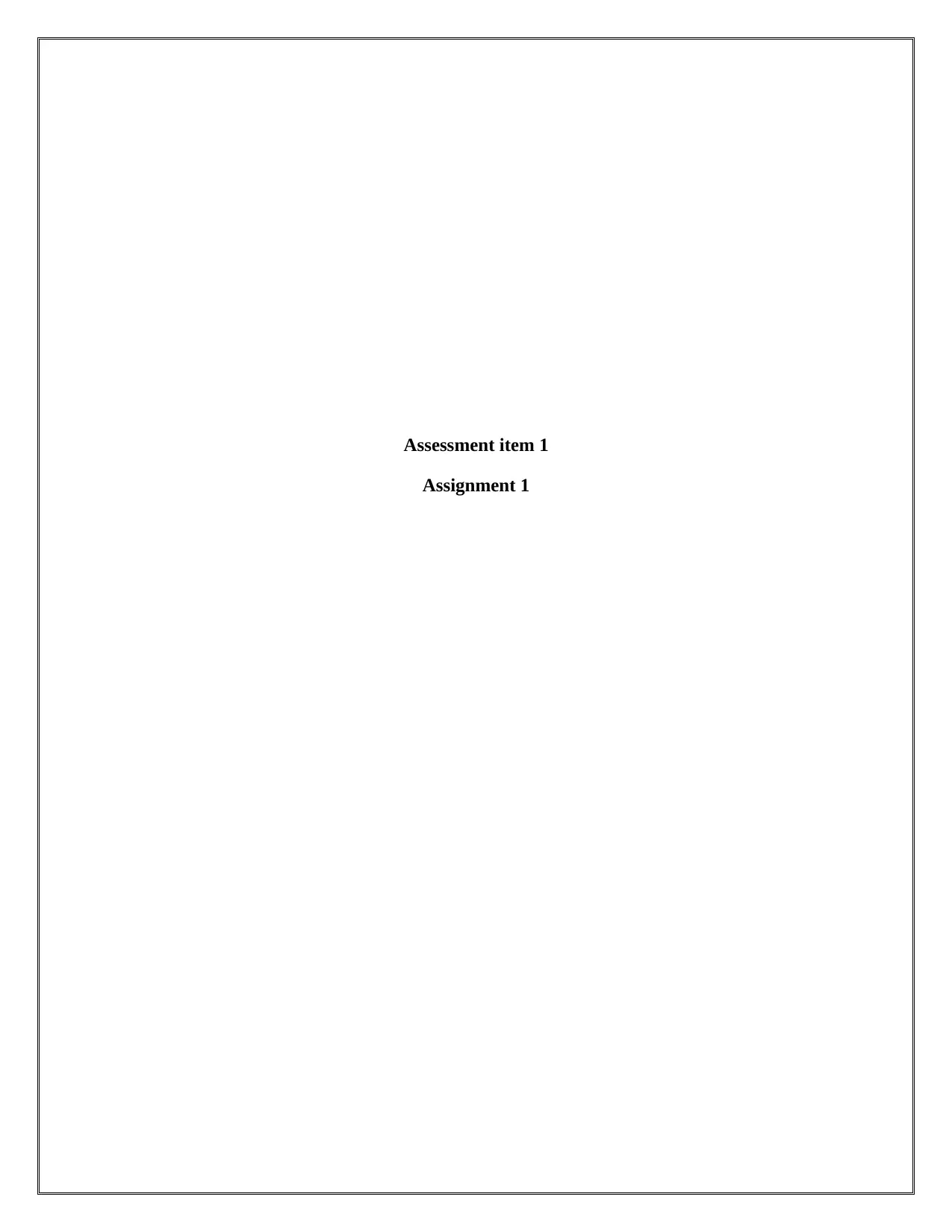
Assessment item 1
Assignment 1
Assignment 1
Secure Best Marks with AI Grader
Need help grading? Try our AI Grader for instant feedback on your assignments.
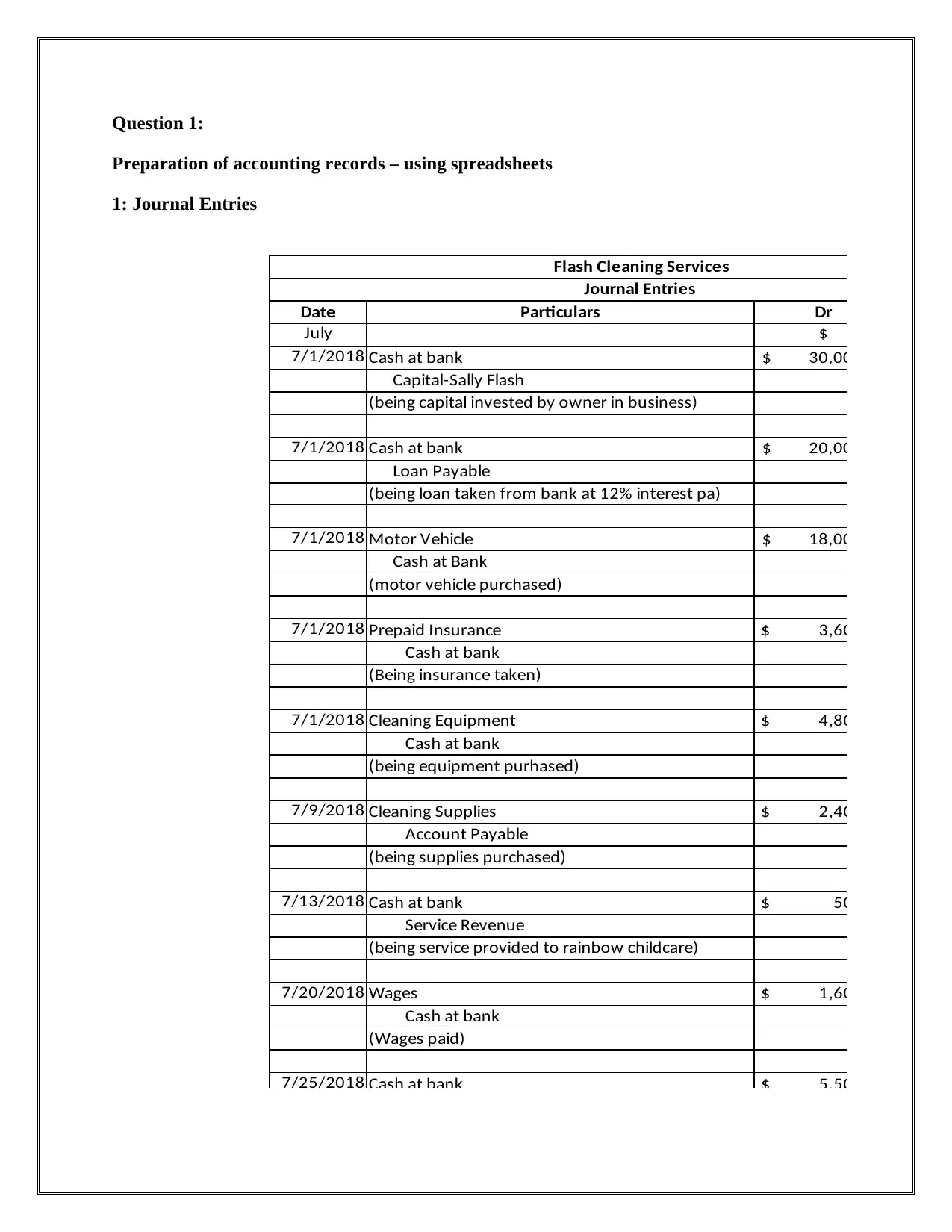
Question 1:
Preparation of accounting records – using spreadsheets
1: Journal Entries
Flash Cleaning Services
Journal Entries
Date Particulars Dr
July $
7/1/2018 Cash at bank $ 30,000.00
Capital-Sally Flash
(being capital invested by owner in business)
7/1/2018 Cash at bank $ 20,000.00
Loan Payable
(being loan taken from bank at 12% interest pa)
7/1/2018 Motor Vehicle $ 18,000.00
Cash at Bank
(motor vehicle purchased)
7/1/2018 Prepaid Insurance $ 3,600.00
Cash at bank
(Being insurance taken)
7/1/2018 Cleaning Equipment $ 4,800.00
Cash at bank
(being equipment purhased)
7/9/2018 Cleaning Supplies $ 2,400.00
Account Payable
(being supplies purchased)
7/13/2018 Cash at bank $ 500.00
Service Revenue
(being service provided to rainbow childcare)
7/20/2018 Wages $ 1,600.00
Cash at bank
(Wages paid)
7/25/2018 Cash at bank $ 5,500.00
Preparation of accounting records – using spreadsheets
1: Journal Entries
Flash Cleaning Services
Journal Entries
Date Particulars Dr
July $
7/1/2018 Cash at bank $ 30,000.00
Capital-Sally Flash
(being capital invested by owner in business)
7/1/2018 Cash at bank $ 20,000.00
Loan Payable
(being loan taken from bank at 12% interest pa)
7/1/2018 Motor Vehicle $ 18,000.00
Cash at Bank
(motor vehicle purchased)
7/1/2018 Prepaid Insurance $ 3,600.00
Cash at bank
(Being insurance taken)
7/1/2018 Cleaning Equipment $ 4,800.00
Cash at bank
(being equipment purhased)
7/9/2018 Cleaning Supplies $ 2,400.00
Account Payable
(being supplies purchased)
7/13/2018 Cash at bank $ 500.00
Service Revenue
(being service provided to rainbow childcare)
7/20/2018 Wages $ 1,600.00
Cash at bank
(Wages paid)
7/25/2018 Cash at bank $ 5,500.00
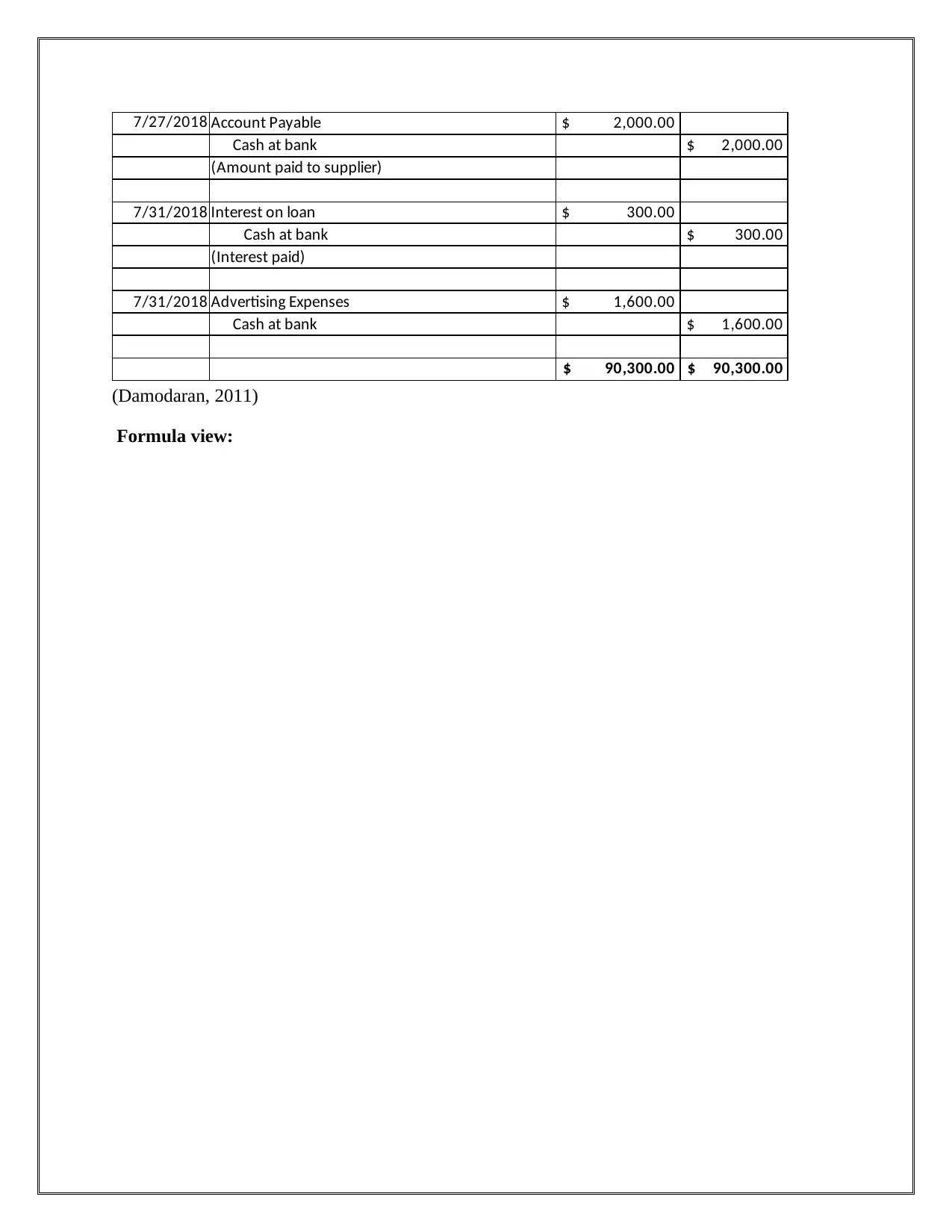
7/27/2018 Account Payable $ 2,000.00
Cash at bank $ 2,000.00
(Amount paid to supplier)
7/31/2018 Interest on loan $ 300.00
Cash at bank $ 300.00
(Interest paid)
7/31/2018 Advertising Expenses $ 1,600.00
Cash at bank $ 1,600.00
$ 90,300.00 $ 90,300.00
(Damodaran, 2011)
Formula view:
Cash at bank $ 2,000.00
(Amount paid to supplier)
7/31/2018 Interest on loan $ 300.00
Cash at bank $ 300.00
(Interest paid)
7/31/2018 Advertising Expenses $ 1,600.00
Cash at bank $ 1,600.00
$ 90,300.00 $ 90,300.00
(Damodaran, 2011)
Formula view:
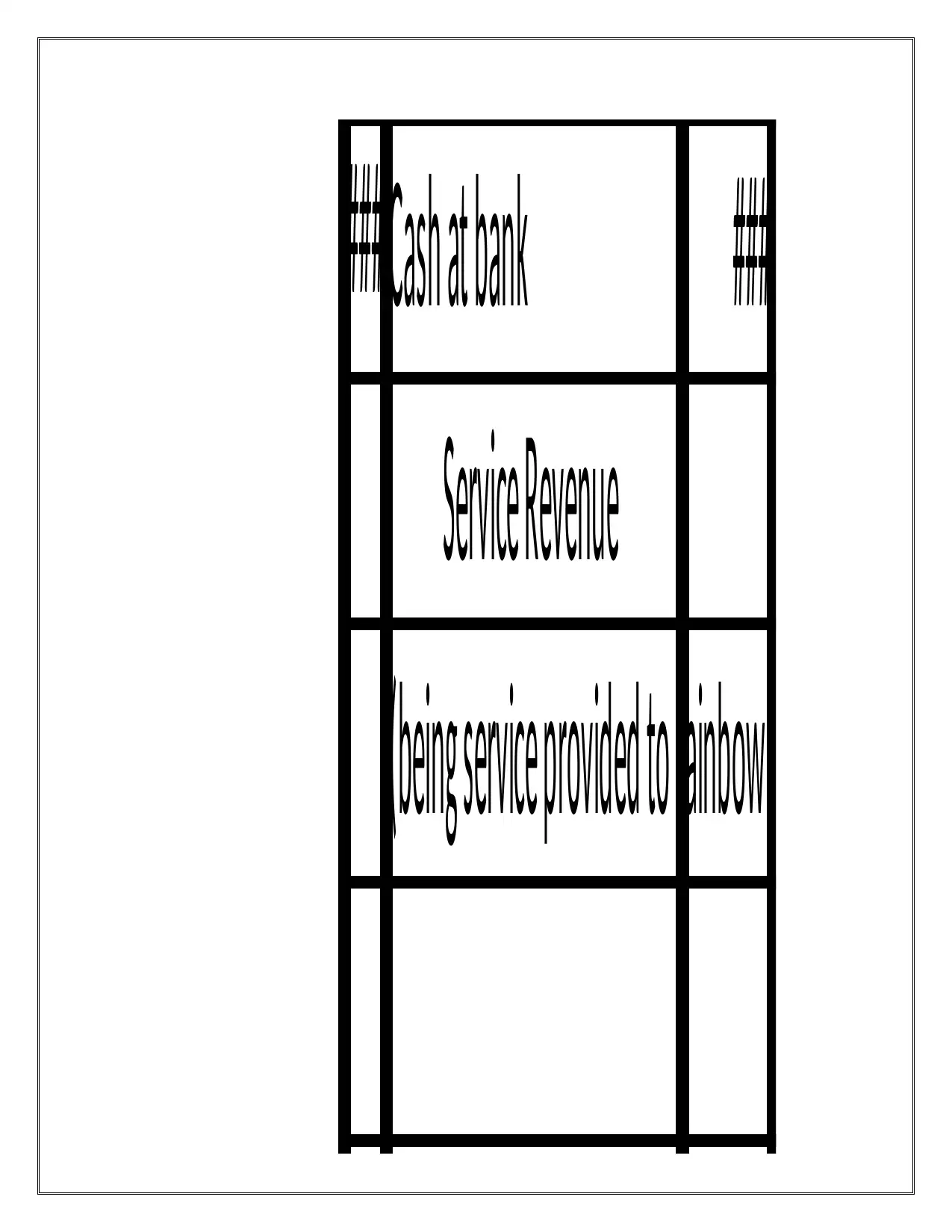
### Cash at bank ###
Service Revenue
(being service provided to rainbow childcare)
Service Revenue
(being service provided to rainbow childcare)
Secure Best Marks with AI Grader
Need help grading? Try our AI Grader for instant feedback on your assignments.
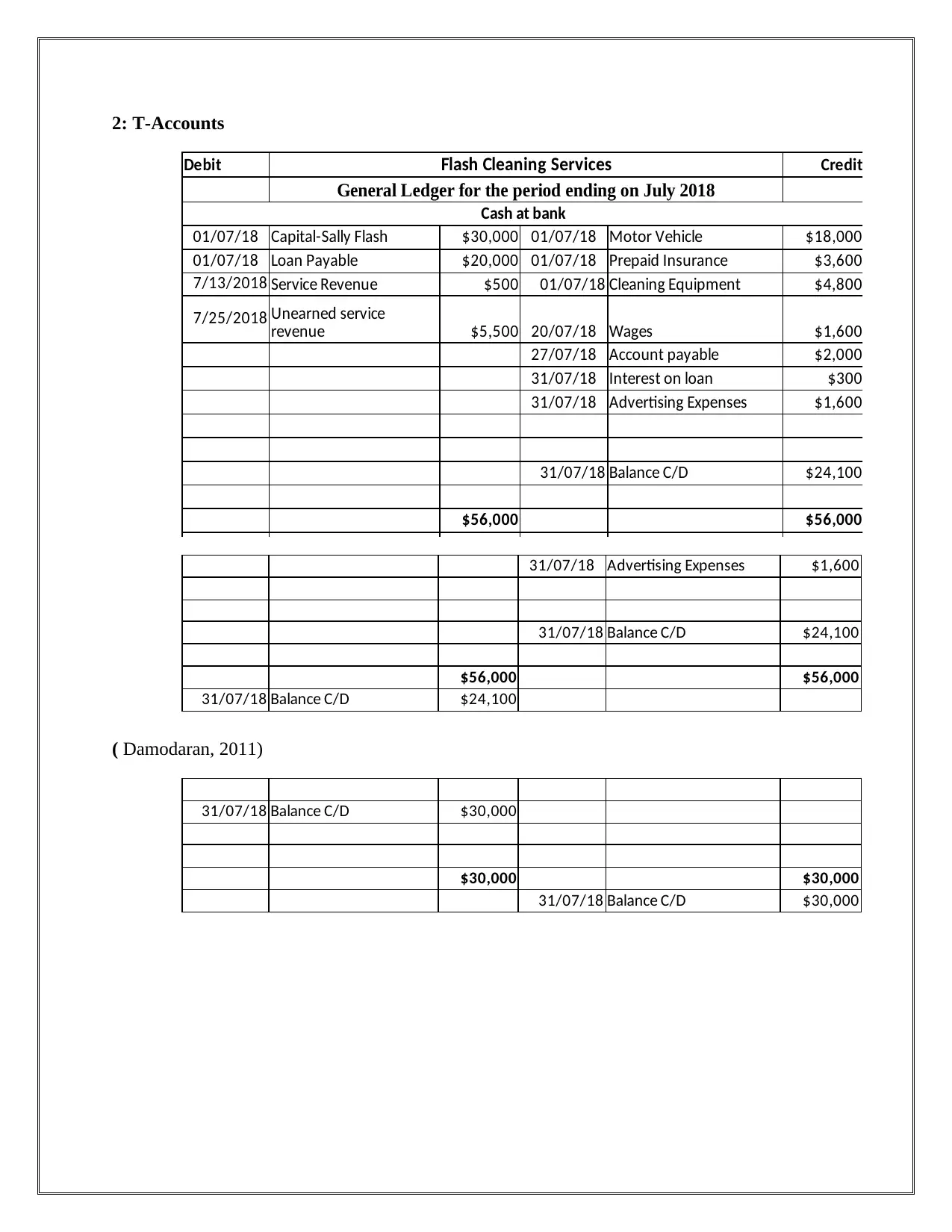
2: T-Accounts
Debit Flash Cleaning Services Credit
General Ledger for the period ending on July 2018
Cash at bank
01/07/18 Capital-Sally Flash $30,000 01/07/18 Motor Vehicle $18,000
01/07/18 Loan Payable $20,000 01/07/18 Prepaid Insurance $3,600
7/13/2018 Service Revenue $500 01/07/18 Cleaning Equipment $4,800
7/25/2018 $5,500 20/07/18 Wages $1,600
27/07/18 Account payable $2,000
31/07/18 Interest on loan $300
31/07/18 Advertising Expenses $1,600
31/07/18 Balance C/D $24,100
$56,000 $56,000
Unearned service
revenue
31/07/18 Advertising Expenses $1,600
31/07/18 Balance C/D $24,100
$56,000 $56,000
31/07/18 Balance C/D $24,100
( Damodaran, 2011)
31/07/18 Balance C/D $30,000
$30,000 $30,000
31/07/18 Balance C/D $30,000
Debit Flash Cleaning Services Credit
General Ledger for the period ending on July 2018
Cash at bank
01/07/18 Capital-Sally Flash $30,000 01/07/18 Motor Vehicle $18,000
01/07/18 Loan Payable $20,000 01/07/18 Prepaid Insurance $3,600
7/13/2018 Service Revenue $500 01/07/18 Cleaning Equipment $4,800
7/25/2018 $5,500 20/07/18 Wages $1,600
27/07/18 Account payable $2,000
31/07/18 Interest on loan $300
31/07/18 Advertising Expenses $1,600
31/07/18 Balance C/D $24,100
$56,000 $56,000
Unearned service
revenue
31/07/18 Advertising Expenses $1,600
31/07/18 Balance C/D $24,100
$56,000 $56,000
31/07/18 Balance C/D $24,100
( Damodaran, 2011)
31/07/18 Balance C/D $30,000
$30,000 $30,000
31/07/18 Balance C/D $30,000
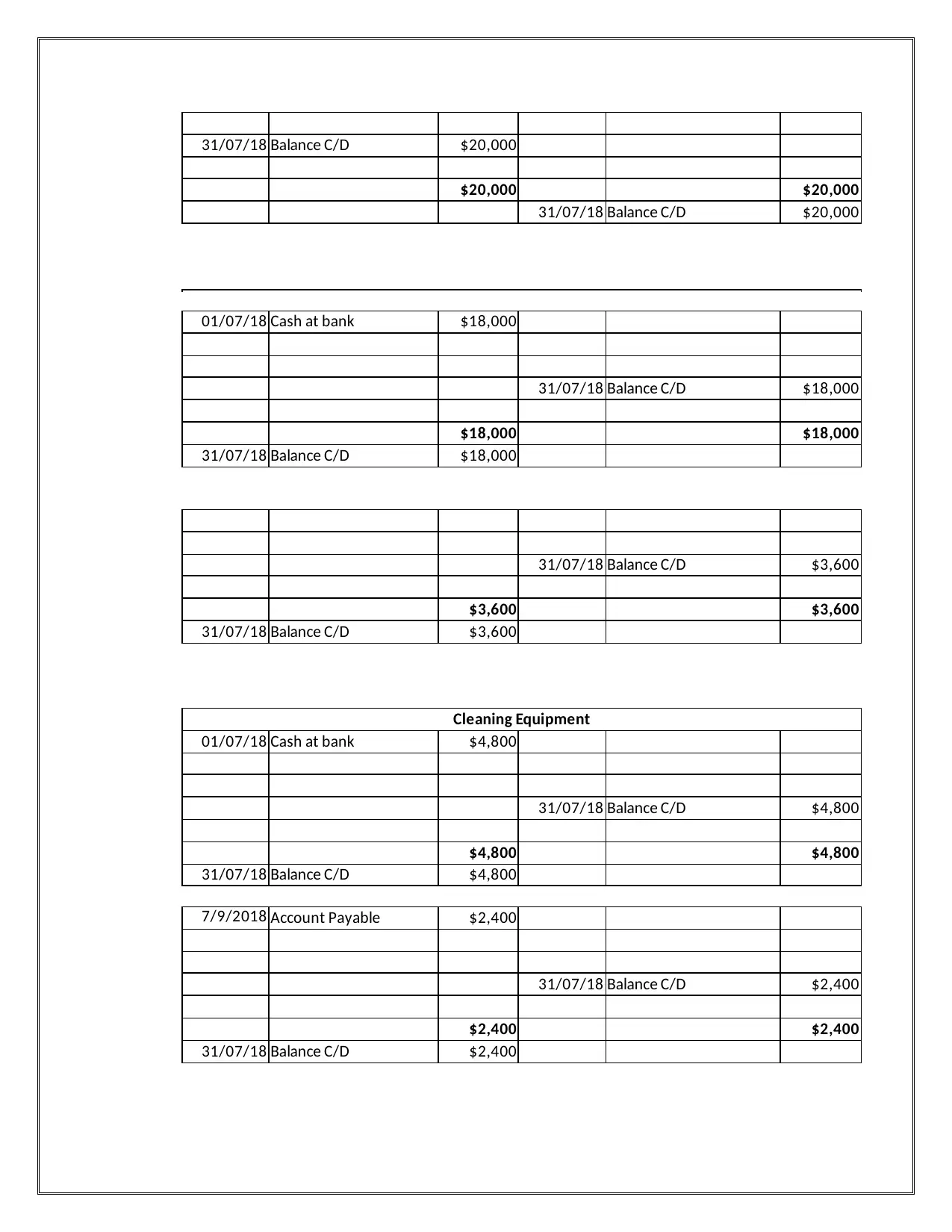
31/07/18 Balance C/D $20,000
$20,000 $20,000
31/07/18 Balance C/D $20,000
01/07/18 Cash at bank $18,000
31/07/18 Balance C/D $18,000
$18,000 $18,000
31/07/18 Balance C/D $18,000
31/07/18 Balance C/D $3,600
$3,600 $3,600
31/07/18 Balance C/D $3,600
Cleaning Equipment
01/07/18 Cash at bank $4,800
31/07/18 Balance C/D $4,800
$4,800 $4,800
31/07/18 Balance C/D $4,800
7/9/2018 Account Payable $2,400
31/07/18 Balance C/D $2,400
$2,400 $2,400
31/07/18 Balance C/D $2,400
$20,000 $20,000
31/07/18 Balance C/D $20,000
01/07/18 Cash at bank $18,000
31/07/18 Balance C/D $18,000
$18,000 $18,000
31/07/18 Balance C/D $18,000
31/07/18 Balance C/D $3,600
$3,600 $3,600
31/07/18 Balance C/D $3,600
Cleaning Equipment
01/07/18 Cash at bank $4,800
31/07/18 Balance C/D $4,800
$4,800 $4,800
31/07/18 Balance C/D $4,800
7/9/2018 Account Payable $2,400
31/07/18 Balance C/D $2,400
$2,400 $2,400
31/07/18 Balance C/D $2,400
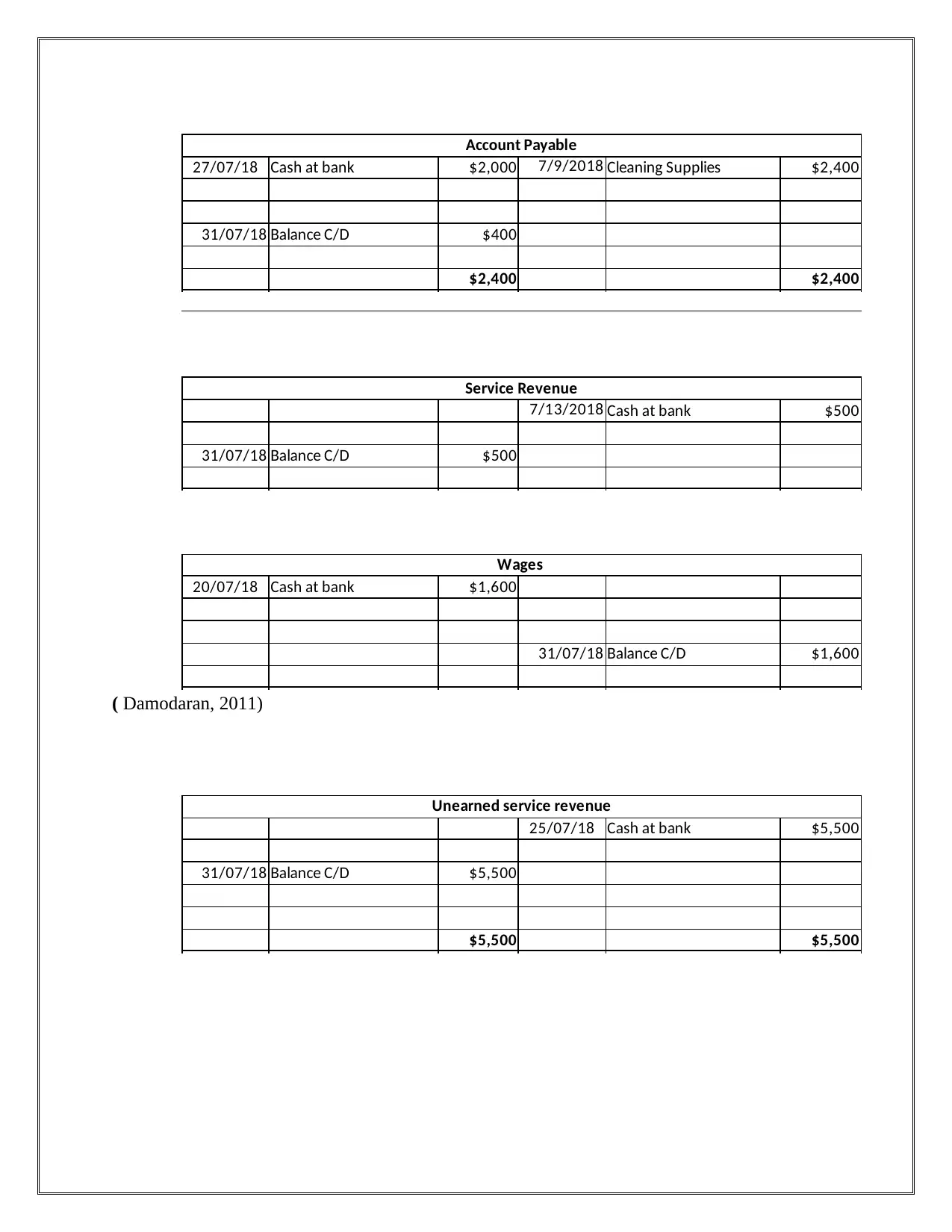
Account Payable
27/07/18 Cash at bank $2,000 7/9/2018 Cleaning Supplies $2,400
31/07/18 Balance C/D $400
$2,400 $2,400
Service Revenue
7/13/2018 Cash at bank $500
31/07/18 Balance C/D $500
Wages
20/07/18 Cash at bank $1,600
31/07/18 Balance C/D $1,600
( Damodaran, 2011)
Unearned service revenue
25/07/18 Cash at bank $5,500
31/07/18 Balance C/D $5,500
$5,500 $5,500
27/07/18 Cash at bank $2,000 7/9/2018 Cleaning Supplies $2,400
31/07/18 Balance C/D $400
$2,400 $2,400
Service Revenue
7/13/2018 Cash at bank $500
31/07/18 Balance C/D $500
Wages
20/07/18 Cash at bank $1,600
31/07/18 Balance C/D $1,600
( Damodaran, 2011)
Unearned service revenue
25/07/18 Cash at bank $5,500
31/07/18 Balance C/D $5,500
$5,500 $5,500
Paraphrase This Document
Need a fresh take? Get an instant paraphrase of this document with our AI Paraphraser
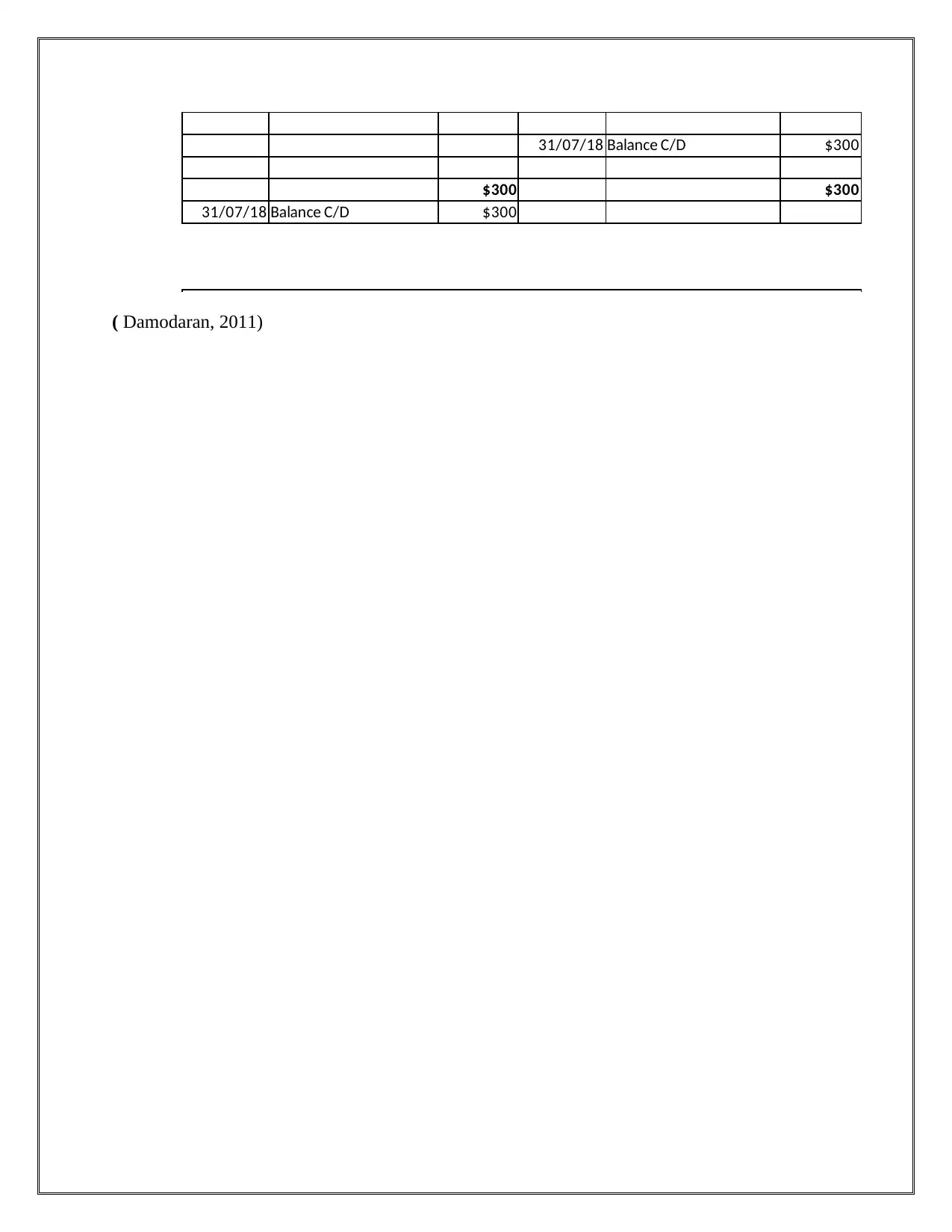
31/07/18 Balance C/D $300
$300 $300
31/07/18 Balance C/D $300
( Damodaran, 2011)
$300 $300
31/07/18 Balance C/D $300
( Damodaran, 2011)
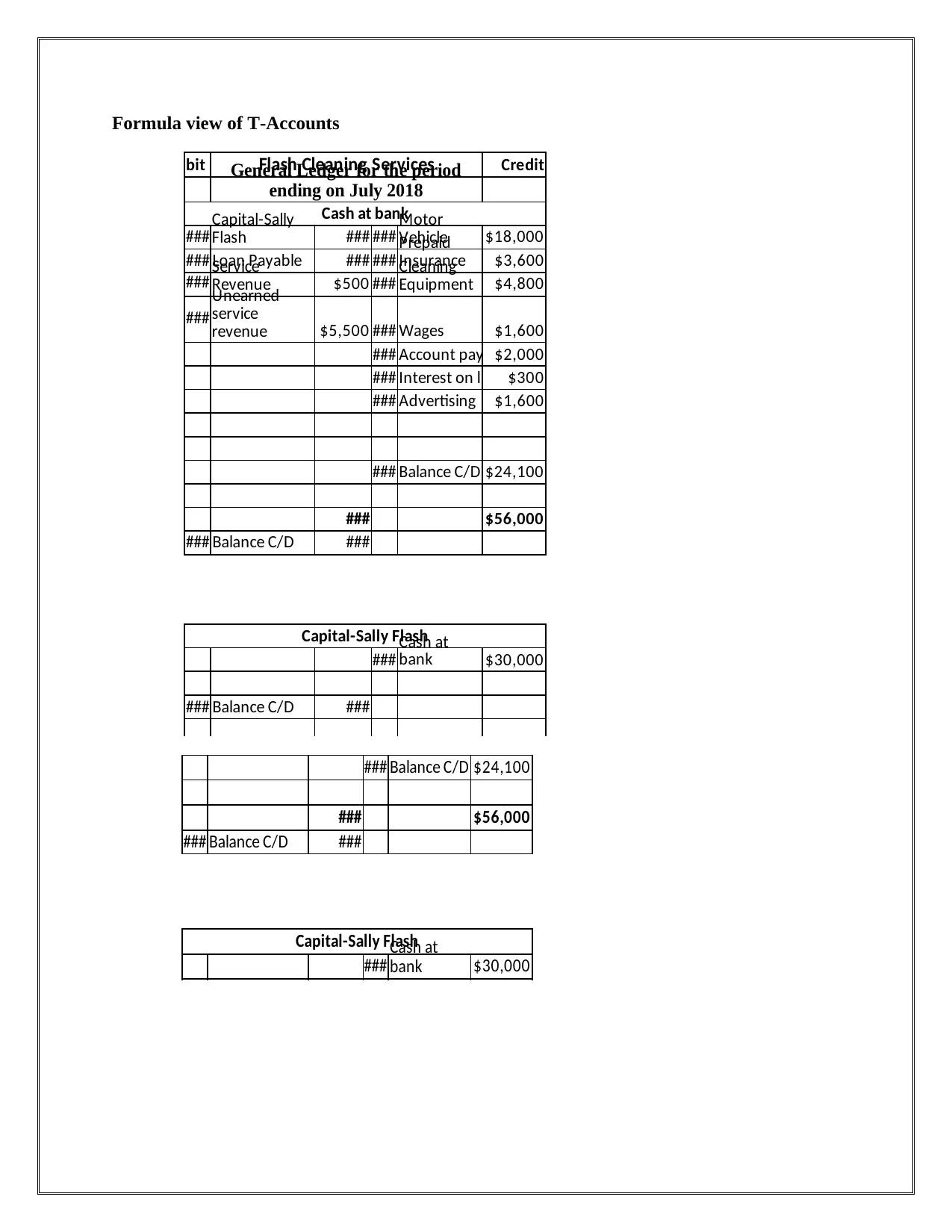
Formula view of T-Accounts
Flash Cleaning Services Credit
Cash at bank
### ### ### $18,000
### Loan Payable ### ### $3,600
### $500 ### $4,800
### $5,500 ### Wages $1,600
### Account pay $2,000
### Interest on l $300
### Advertising $1,600
### Balance C/D $24,100
### $56,000
### Balance C/D ###
Capital-Sally Flash
### $30,000
### Balance C/D ###
De
bit General Ledger for the period
ending on July 2018
Capital-Sally
Flash
Motor
VehiclePrepaid
InsuranceService
Revenue
Cleaning
Equipment
Unearned
service
revenue
Cash at
bank
### Balance C/D $24,100
### $56,000
### Balance C/D ###
Capital-Sally Flash
### $30,000
Cash at
bank
Flash Cleaning Services Credit
Cash at bank
### ### ### $18,000
### Loan Payable ### ### $3,600
### $500 ### $4,800
### $5,500 ### Wages $1,600
### Account pay $2,000
### Interest on l $300
### Advertising $1,600
### Balance C/D $24,100
### $56,000
### Balance C/D ###
Capital-Sally Flash
### $30,000
### Balance C/D ###
De
bit General Ledger for the period
ending on July 2018
Capital-Sally
Flash
Motor
VehiclePrepaid
InsuranceService
Revenue
Cleaning
Equipment
Unearned
service
revenue
Cash at
bank
### Balance C/D $24,100
### $56,000
### Balance C/D ###
Capital-Sally Flash
### $30,000
Cash at
bank

### Balance C/D ###
### $30,000
### Balance C/D $30,000
### Balance C/D ###
### $20,000
### Balance C/D $20,000
Motor Vehicle
### Cash at bank ###
### Balance C/D $18,000
### $18,000
### Balance C/D ###
Prepaid Insurance
### Cash at bank $3,600
### Balance C/D $3,600
$3,600 $3,600
### Balance C/D $3,600
### $30,000
### Balance C/D $30,000
### Balance C/D ###
### $20,000
### Balance C/D $20,000
Motor Vehicle
### Cash at bank ###
### Balance C/D $18,000
### $18,000
### Balance C/D ###
Prepaid Insurance
### Cash at bank $3,600
### Balance C/D $3,600
$3,600 $3,600
### Balance C/D $3,600
Secure Best Marks with AI Grader
Need help grading? Try our AI Grader for instant feedback on your assignments.

Cleaning Equipment
### Cash at bank $4,800
### Balance C/D $4,800
$4,800 $4,800
### Balance C/D $4,800
Cleaning Supplies
### $2,400
### Balance C/D $2,400
$2,400 $2,400
Account
Payable
### Balance C/D $2,400
Account Payable
### Cash at bank $2,000 ### $2,400
### Balance C/D $400
Cleaning
Supplies
Service Revenue
### $500
### Balance C/D $500
$500 $500
### Balance C/D $500
Cash at
bank
### Cash at bank $4,800
### Balance C/D $4,800
$4,800 $4,800
### Balance C/D $4,800
Cleaning Supplies
### $2,400
### Balance C/D $2,400
$2,400 $2,400
Account
Payable
### Balance C/D $2,400
Account Payable
### Cash at bank $2,000 ### $2,400
### Balance C/D $400
Cleaning
Supplies
Service Revenue
### $500
### Balance C/D $500
$500 $500
### Balance C/D $500
Cash at
bank
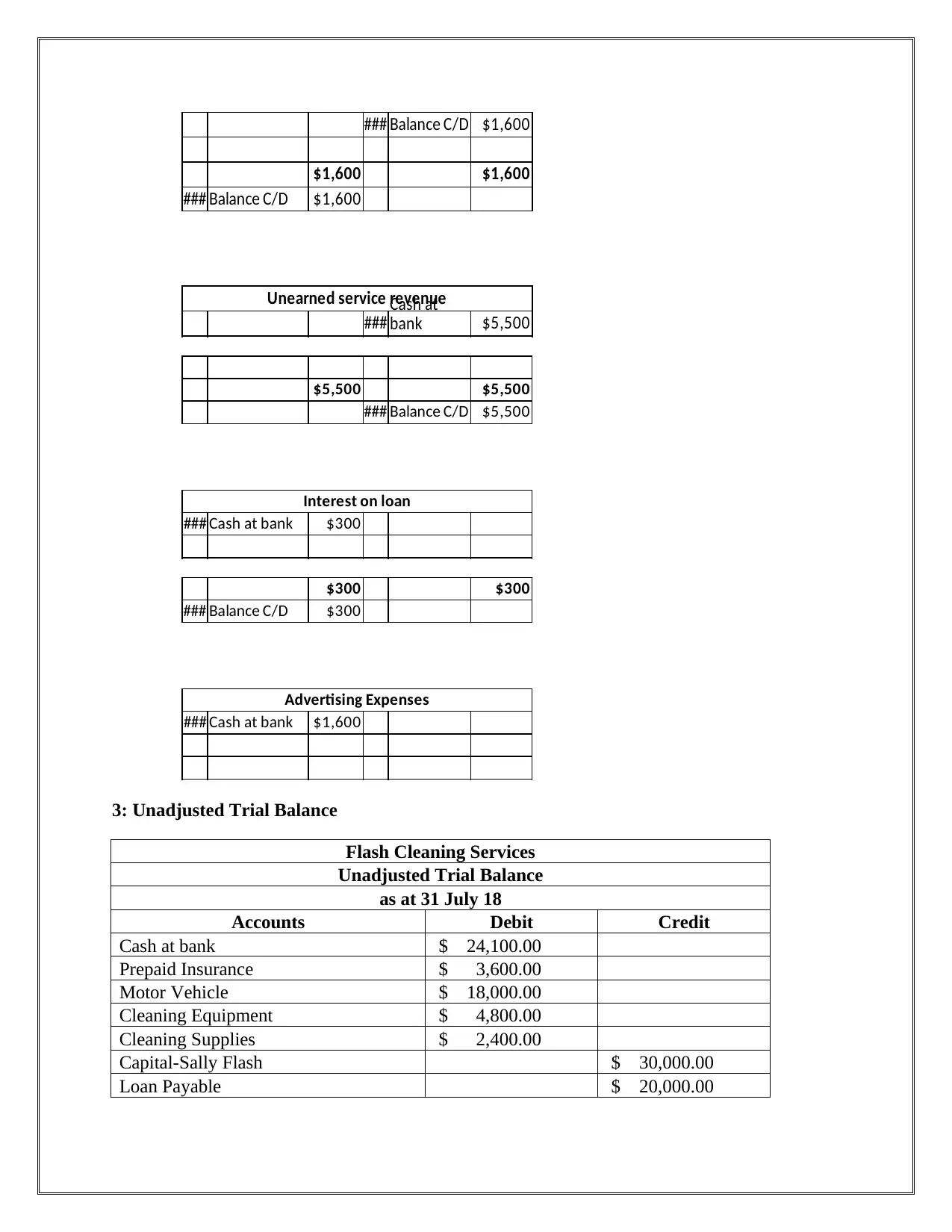
### Balance C/D $1,600
$1,600 $1,600
### Balance C/D $1,600
Unearned service revenue
### $5,500
Cash at
bank
$5,500 $5,500
### Balance C/D $5,500
Interest on loan
### Cash at bank $300
$300 $300
### Balance C/D $300
Advertising Expenses
### Cash at bank $1,600
3: Unadjusted Trial Balance
Flash Cleaning Services
Unadjusted Trial Balance
as at 31 July 18
Accounts Debit Credit
Cash at bank $ 24,100.00
Prepaid Insurance $ 3,600.00
Motor Vehicle $ 18,000.00
Cleaning Equipment $ 4,800.00
Cleaning Supplies $ 2,400.00
Capital-Sally Flash $ 30,000.00
Loan Payable $ 20,000.00
$1,600 $1,600
### Balance C/D $1,600
Unearned service revenue
### $5,500
Cash at
bank
$5,500 $5,500
### Balance C/D $5,500
Interest on loan
### Cash at bank $300
$300 $300
### Balance C/D $300
Advertising Expenses
### Cash at bank $1,600
3: Unadjusted Trial Balance
Flash Cleaning Services
Unadjusted Trial Balance
as at 31 July 18
Accounts Debit Credit
Cash at bank $ 24,100.00
Prepaid Insurance $ 3,600.00
Motor Vehicle $ 18,000.00
Cleaning Equipment $ 4,800.00
Cleaning Supplies $ 2,400.00
Capital-Sally Flash $ 30,000.00
Loan Payable $ 20,000.00
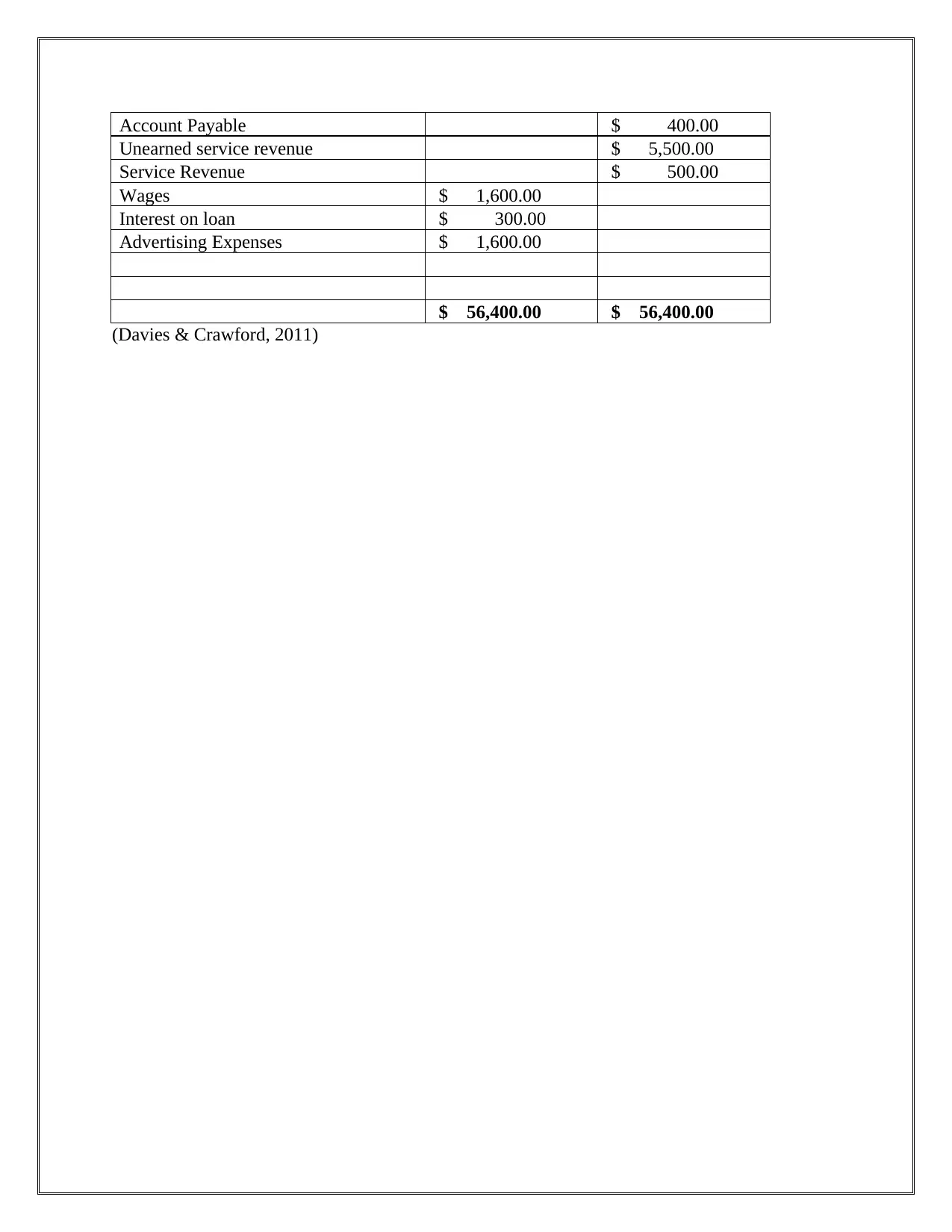
Account Payable $ 400.00
Unearned service revenue $ 5,500.00
Service Revenue $ 500.00
Wages $ 1,600.00
Interest on loan $ 300.00
Advertising Expenses $ 1,600.00
$ 56,400.00 $ 56,400.00
(Davies & Crawford, 2011)
Unearned service revenue $ 5,500.00
Service Revenue $ 500.00
Wages $ 1,600.00
Interest on loan $ 300.00
Advertising Expenses $ 1,600.00
$ 56,400.00 $ 56,400.00
(Davies & Crawford, 2011)
Paraphrase This Document
Need a fresh take? Get an instant paraphrase of this document with our AI Paraphraser
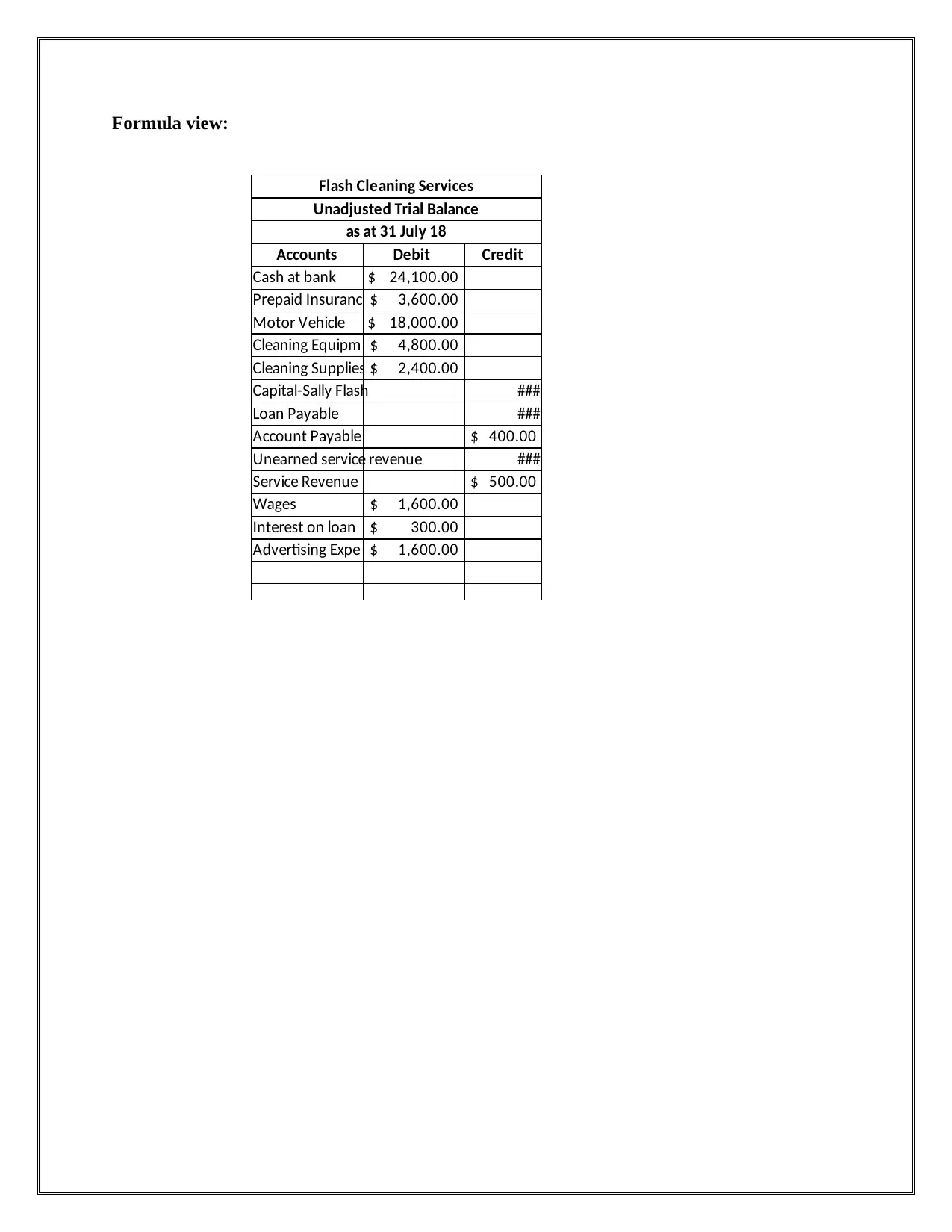
Formula view:
Flash Cleaning Services
Unadjusted Trial Balance
as at 31 July 18
Accounts Debit Credit
Cash at bank $ 24,100.00
Prepaid Insuranc $ 3,600.00
Motor Vehicle $ 18,000.00
Cleaning Equipm $ 4,800.00
Cleaning Supplies $ 2,400.00
Capital-Sally Flash ###
Loan Payable ###
Account Payable $ 400.00
Unearned service revenue ###
Service Revenue $ 500.00
Wages $ 1,600.00
Interest on loan $ 300.00
Advertising Expe $ 1,600.00
Flash Cleaning Services
Unadjusted Trial Balance
as at 31 July 18
Accounts Debit Credit
Cash at bank $ 24,100.00
Prepaid Insuranc $ 3,600.00
Motor Vehicle $ 18,000.00
Cleaning Equipm $ 4,800.00
Cleaning Supplies $ 2,400.00
Capital-Sally Flash ###
Loan Payable ###
Account Payable $ 400.00
Unearned service revenue ###
Service Revenue $ 500.00
Wages $ 1,600.00
Interest on loan $ 300.00
Advertising Expe $ 1,600.00

4: Types of adjusting entries and adjusting entries in the book of accounts of Flash
Cleaning Services as at 31 July 2018
Types of adjusting entries
Prepaid Expenses: Expenses for which liability has not been arise but they have been paid is
termed as prepaid expenses. It create current assets in the balance sheet.
Unearned Revenue: This involves the amount that has been received for services that are not
yet given or for the products that have not been delivered. These are recognized as liability till
the service is performed completely.
Accrued Expenses: This involve the adjusting entries that re developed at the end of an
accounting year for recording the amounts that have been incurred in the current years but have
not been recorded in the ledger.
Accrued Revenue: Revenue which has been earned but received has been classified as accrued
revenue and it create debit balance in books of accounts
Depreciation expense: Depreciation is the adjusting amount that is used to divide the cost of
assets into its useful life (Damodaran, 2011)
Cleaning Services as at 31 July 2018
Types of adjusting entries
Prepaid Expenses: Expenses for which liability has not been arise but they have been paid is
termed as prepaid expenses. It create current assets in the balance sheet.
Unearned Revenue: This involves the amount that has been received for services that are not
yet given or for the products that have not been delivered. These are recognized as liability till
the service is performed completely.
Accrued Expenses: This involve the adjusting entries that re developed at the end of an
accounting year for recording the amounts that have been incurred in the current years but have
not been recorded in the ledger.
Accrued Revenue: Revenue which has been earned but received has been classified as accrued
revenue and it create debit balance in books of accounts
Depreciation expense: Depreciation is the adjusting amount that is used to divide the cost of
assets into its useful life (Damodaran, 2011)
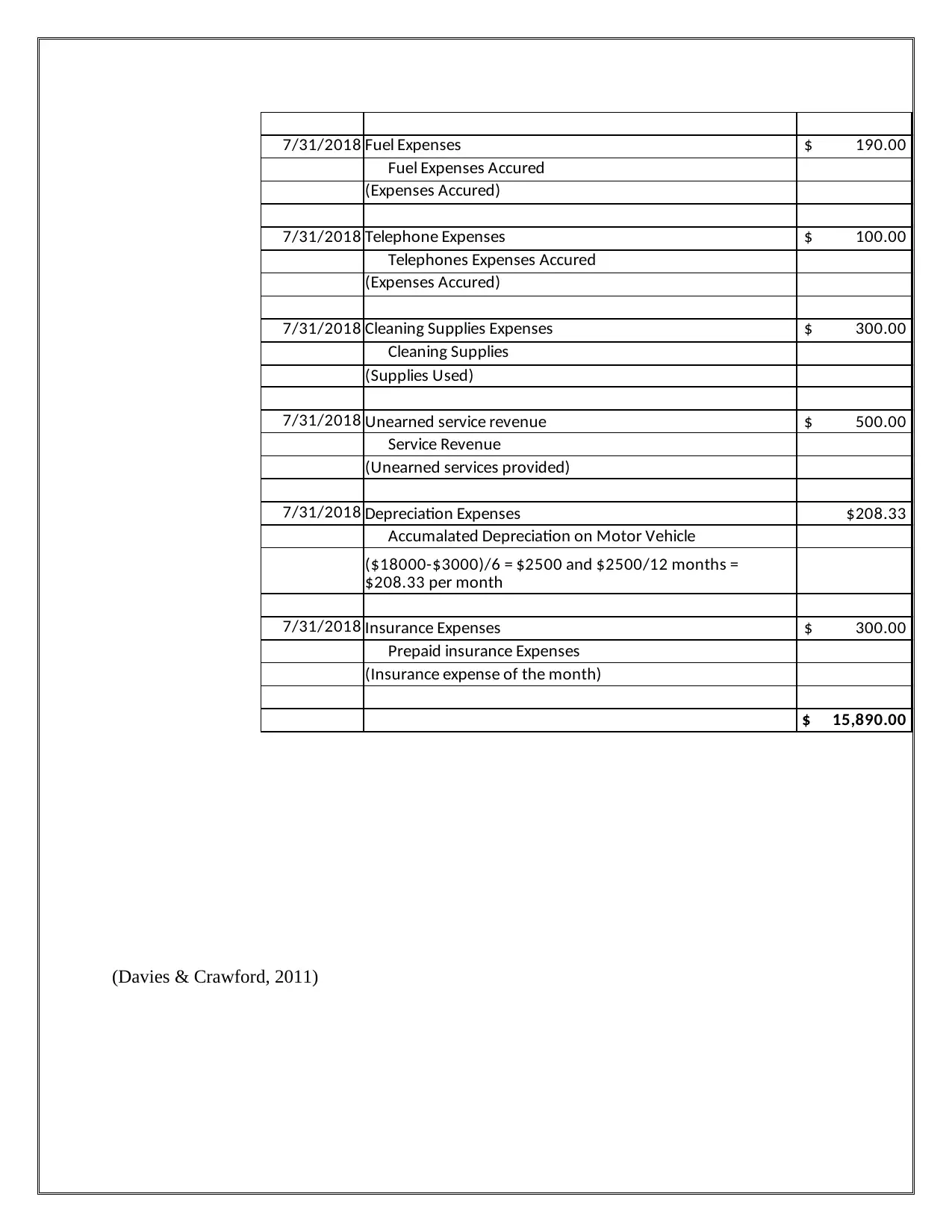
7/31/2018 Fuel Expenses $ 190.00
Fuel Expenses Accured
(Expenses Accured)
7/31/2018 Telephone Expenses $ 100.00
Telephones Expenses Accured
(Expenses Accured)
7/31/2018 Cleaning Supplies Expenses $ 300.00
Cleaning Supplies
(Supplies Used)
7/31/2018 Unearned service revenue $ 500.00
Service Revenue
(Unearned services provided)
7/31/2018 Depreciation Expenses $208.33
Accumalated Depreciation on Motor Vehicle
7/31/2018 Insurance Expenses $ 300.00
Prepaid insurance Expenses
(Insurance expense of the month)
$ 15,890.00
($18000-$3000)/6 = $2500 and $2500/12 months =
$208.33 per month
(Davies & Crawford, 2011)
Fuel Expenses Accured
(Expenses Accured)
7/31/2018 Telephone Expenses $ 100.00
Telephones Expenses Accured
(Expenses Accured)
7/31/2018 Cleaning Supplies Expenses $ 300.00
Cleaning Supplies
(Supplies Used)
7/31/2018 Unearned service revenue $ 500.00
Service Revenue
(Unearned services provided)
7/31/2018 Depreciation Expenses $208.33
Accumalated Depreciation on Motor Vehicle
7/31/2018 Insurance Expenses $ 300.00
Prepaid insurance Expenses
(Insurance expense of the month)
$ 15,890.00
($18000-$3000)/6 = $2500 and $2500/12 months =
$208.33 per month
(Davies & Crawford, 2011)
Secure Best Marks with AI Grader
Need help grading? Try our AI Grader for instant feedback on your assignments.
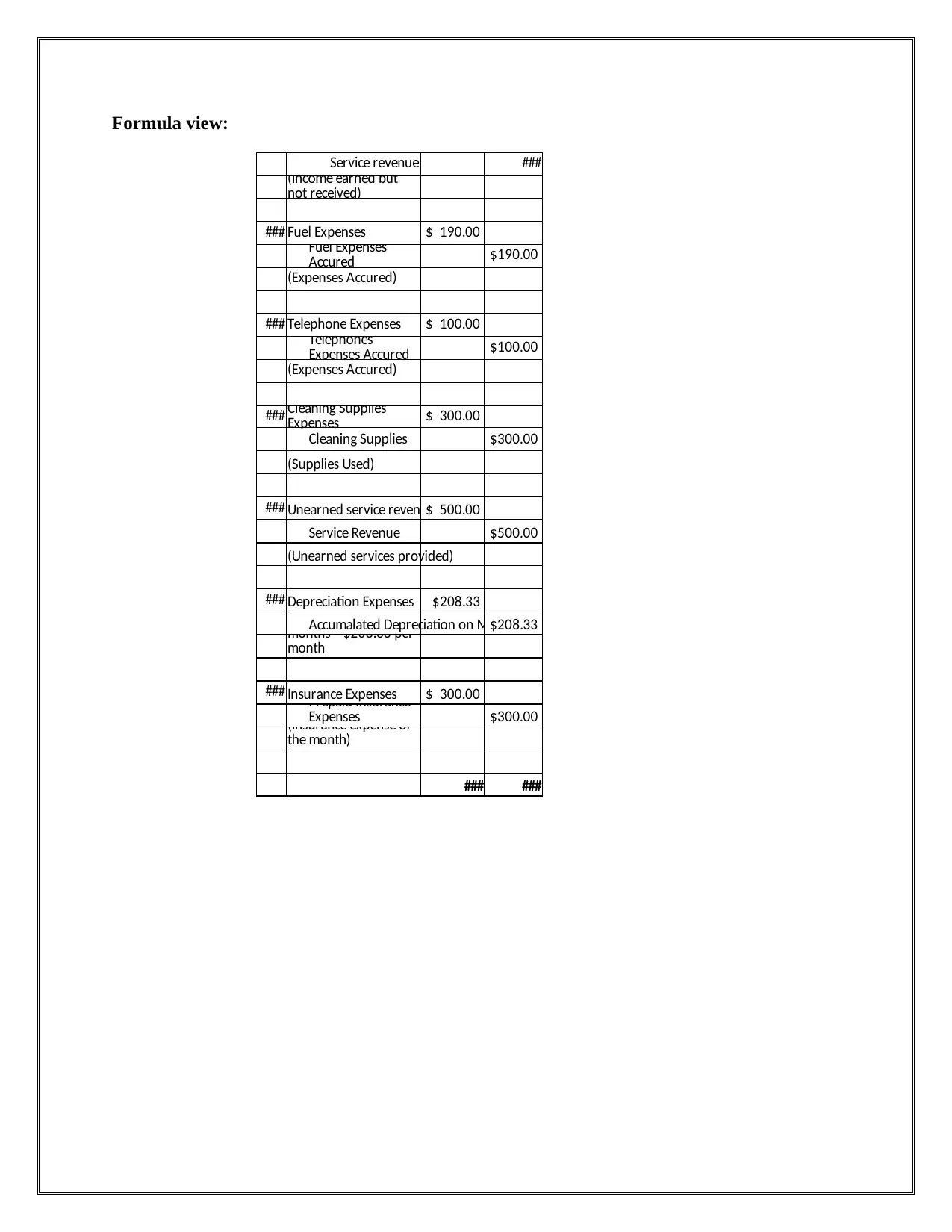
Formula view:
Service revenue ###
### Fuel Expenses $ 190.00
$190.00
(Expenses Accured)
### Telephone Expenses $ 100.00
$100.00
(Expenses Accured)
### $ 300.00
Cleaning Supplies $300.00
(Supplies Used)
### Unearned service reven $ 500.00
Service Revenue $500.00
(Unearned services provided)
### Depreciation Expenses $208.33
Accumalated Depreciation on M$208.33
### Insurance Expenses $ 300.00
$300.00
### ###
(Income earned but
not received)
Fuel Expenses
Accured
Telephones
Expenses Accured
Cleaning Supplies
Expenses
($18000-$3000)/6 =
$2500 and $2500/12
months = $208.33 per
month
Prepaid insurance
Expenses
(Insurance expense of
the month)
Service revenue ###
### Fuel Expenses $ 190.00
$190.00
(Expenses Accured)
### Telephone Expenses $ 100.00
$100.00
(Expenses Accured)
### $ 300.00
Cleaning Supplies $300.00
(Supplies Used)
### Unearned service reven $ 500.00
Service Revenue $500.00
(Unearned services provided)
### Depreciation Expenses $208.33
Accumalated Depreciation on M$208.33
### Insurance Expenses $ 300.00
$300.00
### ###
(Income earned but
not received)
Fuel Expenses
Accured
Telephones
Expenses Accured
Cleaning Supplies
Expenses
($18000-$3000)/6 =
$2500 and $2500/12
months = $208.33 per
month
Prepaid insurance
Expenses
(Insurance expense of
the month)
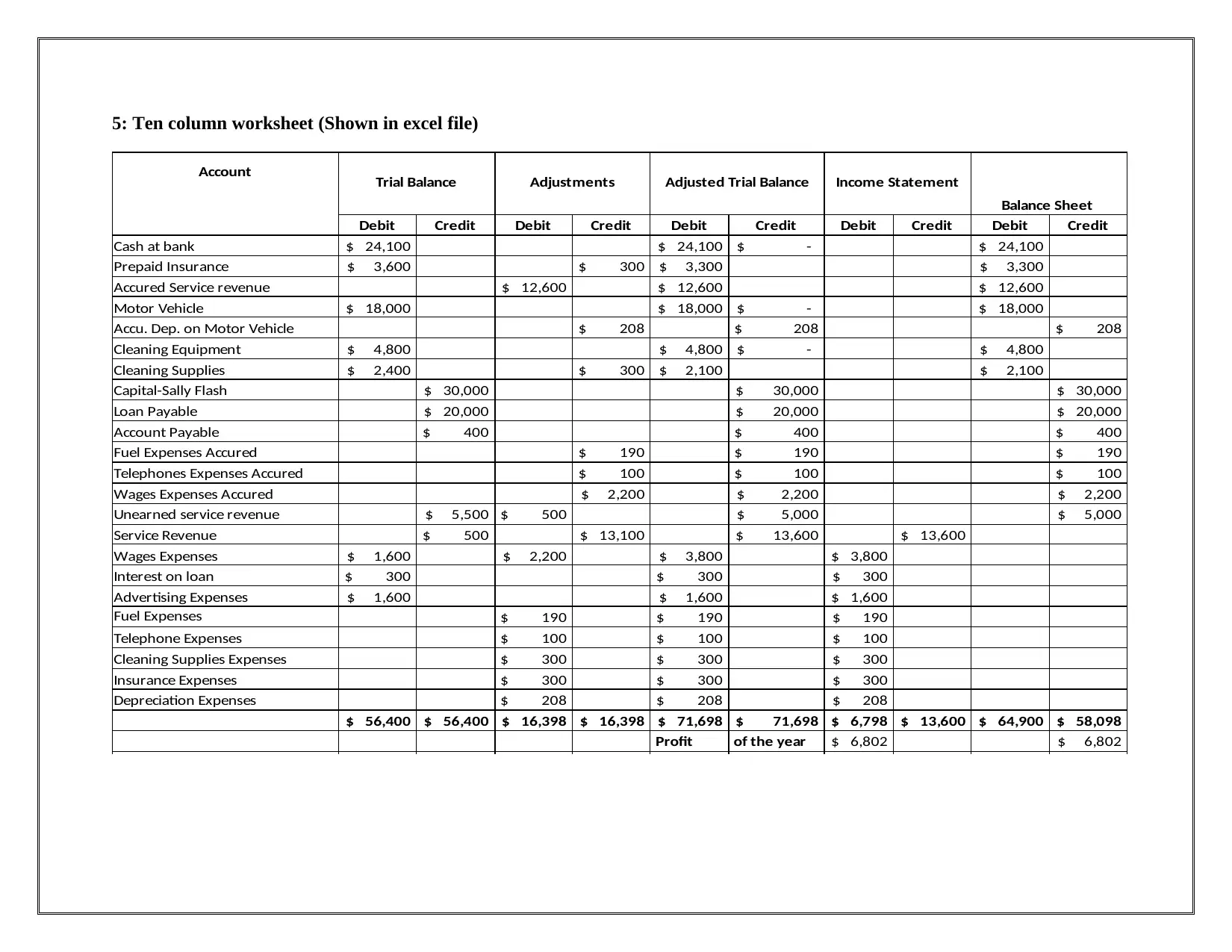
5: Ten column worksheet (Shown in excel file)
Account Trial Balance Adjustments Adjusted Trial Balance Income Statement
Balance Sheet
Debit Credit Debit Credit Debit Credit Debit Credit Debit Credit
Cash at bank $ 24,100 $ 24,100 $ - $ 24,100
Prepaid Insurance $ 3,600 $ 300 $ 3,300 $ 3,300
Accured Service revenue $ 12,600 $ 12,600 $ 12,600
Motor Vehicle $ 18,000 $ 18,000 $ - $ 18,000
Accu. Dep. on Motor Vehicle $ 208 $ 208 $ 208
Cleaning Equipment $ 4,800 $ 4,800 $ - $ 4,800
Cleaning Supplies $ 2,400 $ 300 $ 2,100 $ 2,100
Capital-Sally Flash $ 30,000 $ 30,000 $ 30,000
Loan Payable $ 20,000 $ 20,000 $ 20,000
Account Payable $ 400 $ 400 $ 400
Fuel Expenses Accured $ 190 $ 190 $ 190
Telephones Expenses Accured $ 100 $ 100 $ 100
Wages Expenses Accured $ 2,200 $ 2,200 $ 2,200
Unearned service revenue $ 5,500 $ 500 $ 5,000 $ 5,000
Service Revenue $ 500 $ 13,100 $ 13,600 $ 13,600
Wages Expenses $ 1,600 $ 2,200 $ 3,800 $ 3,800
Interest on loan $ 300 $ 300 $ 300
Advertising Expenses $ 1,600 $ 1,600 $ 1,600
Fuel Expenses $ 190 $ 190 $ 190
Telephone Expenses $ 100 $ 100 $ 100
Cleaning Supplies Expenses $ 300 $ 300 $ 300
Insurance Expenses $ 300 $ 300 $ 300
Depreciation Expenses $ 208 $ 208 $ 208
$ 56,400 $ 56,400 $ 16,398 $ 16,398 $ 71,698 $ 71,698 $ 6,798 $ 13,600 $ 64,900 $ 58,098
Profit of the year $ 6,802 $ 6,802
Account Trial Balance Adjustments Adjusted Trial Balance Income Statement
Balance Sheet
Debit Credit Debit Credit Debit Credit Debit Credit Debit Credit
Cash at bank $ 24,100 $ 24,100 $ - $ 24,100
Prepaid Insurance $ 3,600 $ 300 $ 3,300 $ 3,300
Accured Service revenue $ 12,600 $ 12,600 $ 12,600
Motor Vehicle $ 18,000 $ 18,000 $ - $ 18,000
Accu. Dep. on Motor Vehicle $ 208 $ 208 $ 208
Cleaning Equipment $ 4,800 $ 4,800 $ - $ 4,800
Cleaning Supplies $ 2,400 $ 300 $ 2,100 $ 2,100
Capital-Sally Flash $ 30,000 $ 30,000 $ 30,000
Loan Payable $ 20,000 $ 20,000 $ 20,000
Account Payable $ 400 $ 400 $ 400
Fuel Expenses Accured $ 190 $ 190 $ 190
Telephones Expenses Accured $ 100 $ 100 $ 100
Wages Expenses Accured $ 2,200 $ 2,200 $ 2,200
Unearned service revenue $ 5,500 $ 500 $ 5,000 $ 5,000
Service Revenue $ 500 $ 13,100 $ 13,600 $ 13,600
Wages Expenses $ 1,600 $ 2,200 $ 3,800 $ 3,800
Interest on loan $ 300 $ 300 $ 300
Advertising Expenses $ 1,600 $ 1,600 $ 1,600
Fuel Expenses $ 190 $ 190 $ 190
Telephone Expenses $ 100 $ 100 $ 100
Cleaning Supplies Expenses $ 300 $ 300 $ 300
Insurance Expenses $ 300 $ 300 $ 300
Depreciation Expenses $ 208 $ 208 $ 208
$ 56,400 $ 56,400 $ 16,398 $ 16,398 $ 71,698 $ 71,698 $ 6,798 $ 13,600 $ 64,900 $ 58,098
Profit of the year $ 6,802 $ 6,802
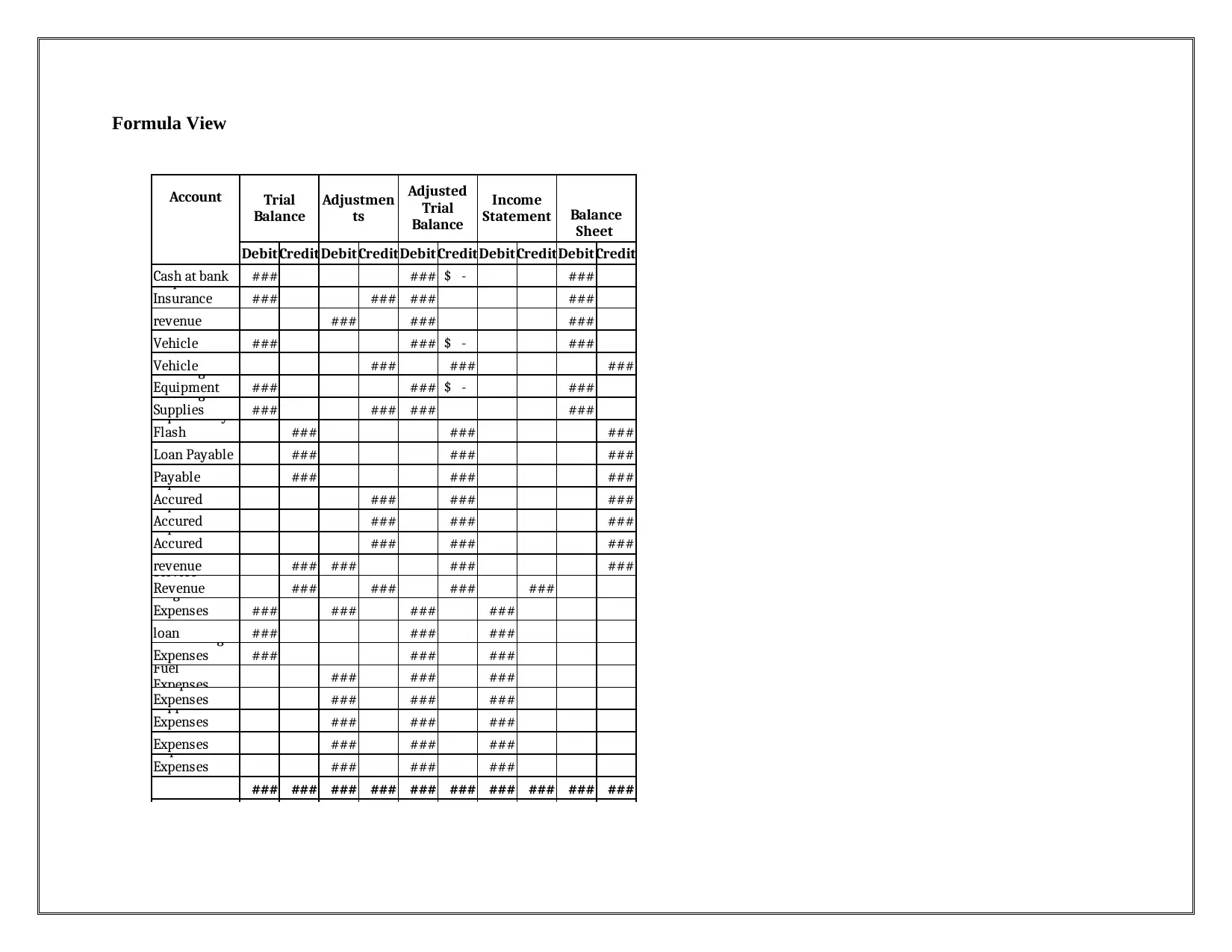
Formula View
Account
DebitCreditDebitCreditDebitCreditDebitCreditDebitCredit
Cash at bank ### ### $ - ###
### ### ### ###
### ### ###
### ### $ - ###
### ### ###
### ### $ - ###
### ### ### ###
### ### ###
Loan Payable ### ### ###
### ### ###
### ### ###
### ### ###
### ### ###
### ### ### ###
### ### ### ###
### ### ### ###
### ### ###
### ### ###
### ### ###
### ### ###
### ### ###
### ### ###
### ### ###
### ### ### ### ### ### ### ### ### ###
Trial
Balance
Adjustmen
ts
Adjusted
Trial
Balance
Income
Statement Balance
Sheet
Prepaid
Insurance
Accured
Service
revenueMotor
Vehicle
Accu. Dep. on
Motor
VehicleCleaning
EquipmentCleaning
SuppliesCapital-Sally
Flash
Account
Payable
Fuel
Expenses
Accured
Telephones
Expenses
Accured
Wages
Expenses
Accured
Unearned
service
revenueService
RevenueWages
ExpensesInterest on
loanAdvertising
Expenses
Fuel
ExpensesTelephone
Expenses
Cleaning
Supplies
ExpensesInsurance
ExpensesDepreciation
Expenses
Account
DebitCreditDebitCreditDebitCreditDebitCreditDebitCredit
Cash at bank ### ### $ - ###
### ### ### ###
### ### ###
### ### $ - ###
### ### ###
### ### $ - ###
### ### ### ###
### ### ###
Loan Payable ### ### ###
### ### ###
### ### ###
### ### ###
### ### ###
### ### ### ###
### ### ### ###
### ### ### ###
### ### ###
### ### ###
### ### ###
### ### ###
### ### ###
### ### ###
### ### ###
### ### ### ### ### ### ### ### ### ###
Trial
Balance
Adjustmen
ts
Adjusted
Trial
Balance
Income
Statement Balance
Sheet
Prepaid
Insurance
Accured
Service
revenueMotor
Vehicle
Accu. Dep. on
Motor
VehicleCleaning
EquipmentCleaning
SuppliesCapital-Sally
Flash
Account
Payable
Fuel
Expenses
Accured
Telephones
Expenses
Accured
Wages
Expenses
Accured
Unearned
service
revenueService
RevenueWages
ExpensesInterest on
loanAdvertising
Expenses
Fuel
ExpensesTelephone
Expenses
Cleaning
Supplies
ExpensesInsurance
ExpensesDepreciation
Expenses
Paraphrase This Document
Need a fresh take? Get an instant paraphrase of this document with our AI Paraphraser
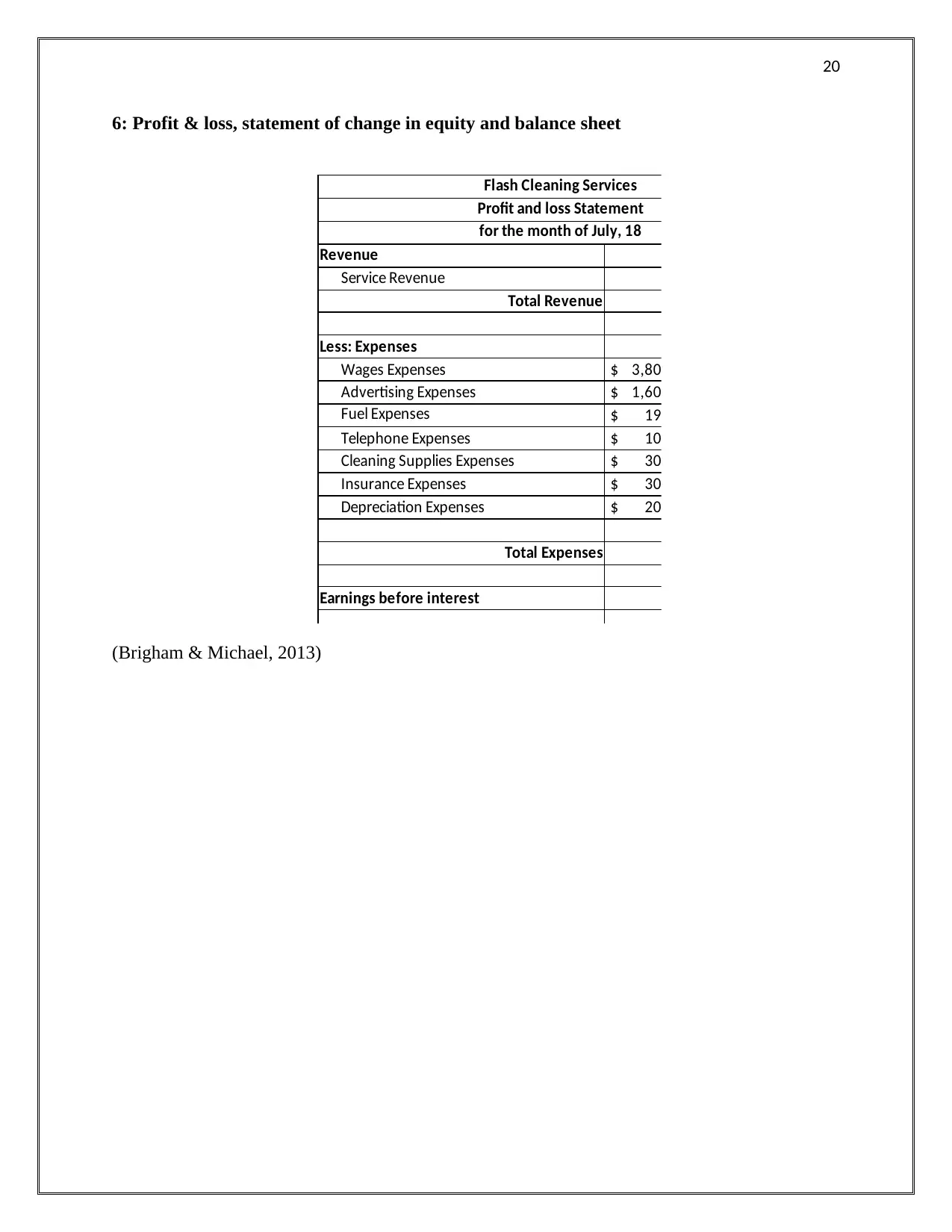
20
6: Profit & loss, statement of change in equity and balance sheet
Flash Cleaning Services
Profit and loss Statement
for the month of July, 18
Revenue
Service Revenue
Total Revenue
Less: Expenses
Wages Expenses $ 3,800.00
Advertising Expenses $ 1,600.00
Fuel Expenses $ 190.00
Telephone Expenses $ 100.00
Cleaning Supplies Expenses $ 300.00
Insurance Expenses $ 300.00
Depreciation Expenses $ 208.33
Total Expenses
Earnings before interest
(Brigham & Michael, 2013)
6: Profit & loss, statement of change in equity and balance sheet
Flash Cleaning Services
Profit and loss Statement
for the month of July, 18
Revenue
Service Revenue
Total Revenue
Less: Expenses
Wages Expenses $ 3,800.00
Advertising Expenses $ 1,600.00
Fuel Expenses $ 190.00
Telephone Expenses $ 100.00
Cleaning Supplies Expenses $ 300.00
Insurance Expenses $ 300.00
Depreciation Expenses $ 208.33
Total Expenses
Earnings before interest
(Brigham & Michael, 2013)

21
Formula view:
Flash Cleaning Services
Profit and loss Statement
for the month of July, 18
Revenue
Service Revenue $ 13,600.00
Total Revenue $ 13,600.00
Less: Expenses
Wages Expenses $ 3,800.00
Advertising Expen $ 1,600.00
Fuel Expenses $ 190.00
Telephone Expens $ 100.00
Cleaning Supplies $ 300.00
Insurance Expense$ 300.00
Depreciation Expe $ 208.33
Total Expenses $ 6,498.33
Earnings before interest $ 7,101.67
Formula view:
Flash Cleaning Services
Profit and loss Statement
for the month of July, 18
Revenue
Service Revenue $ 13,600.00
Total Revenue $ 13,600.00
Less: Expenses
Wages Expenses $ 3,800.00
Advertising Expen $ 1,600.00
Fuel Expenses $ 190.00
Telephone Expens $ 100.00
Cleaning Supplies $ 300.00
Insurance Expense$ 300.00
Depreciation Expe $ 208.33
Total Expenses $ 6,498.33
Earnings before interest $ 7,101.67
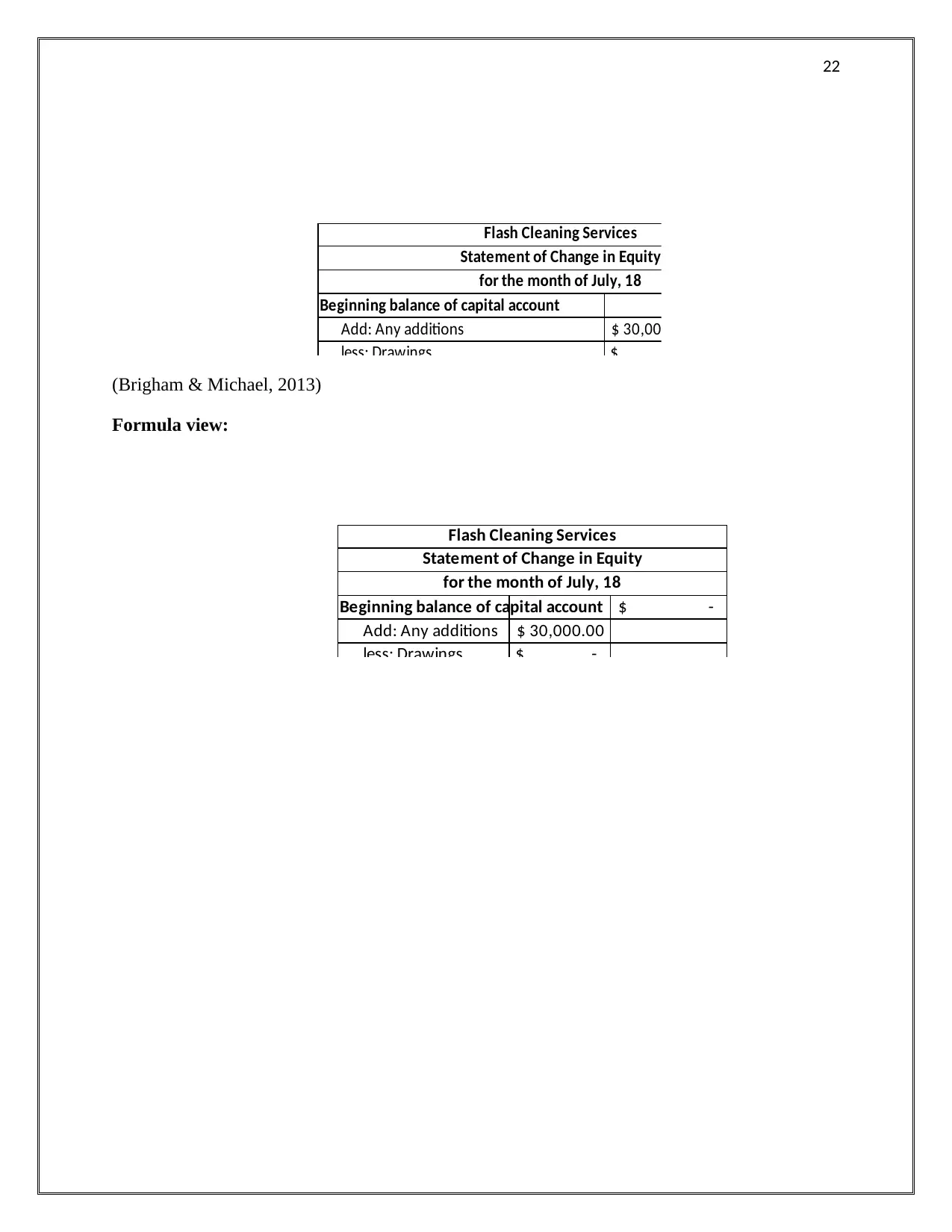
22
Flash Cleaning Services
Statement of Change in Equity
for the month of July, 18
Beginning balance of capital account
Add: Any additions $ 30,000.00
less: Drawings $ -
(Brigham & Michael, 2013)
Formula view:
Flash Cleaning Services
Statement of Change in Equity
for the month of July, 18
Beginning balance of capital account $ -
Add: Any additions $ 30,000.00
less: Drawings $ -
Flash Cleaning Services
Statement of Change in Equity
for the month of July, 18
Beginning balance of capital account
Add: Any additions $ 30,000.00
less: Drawings $ -
(Brigham & Michael, 2013)
Formula view:
Flash Cleaning Services
Statement of Change in Equity
for the month of July, 18
Beginning balance of capital account $ -
Add: Any additions $ 30,000.00
less: Drawings $ -
Secure Best Marks with AI Grader
Need help grading? Try our AI Grader for instant feedback on your assignments.
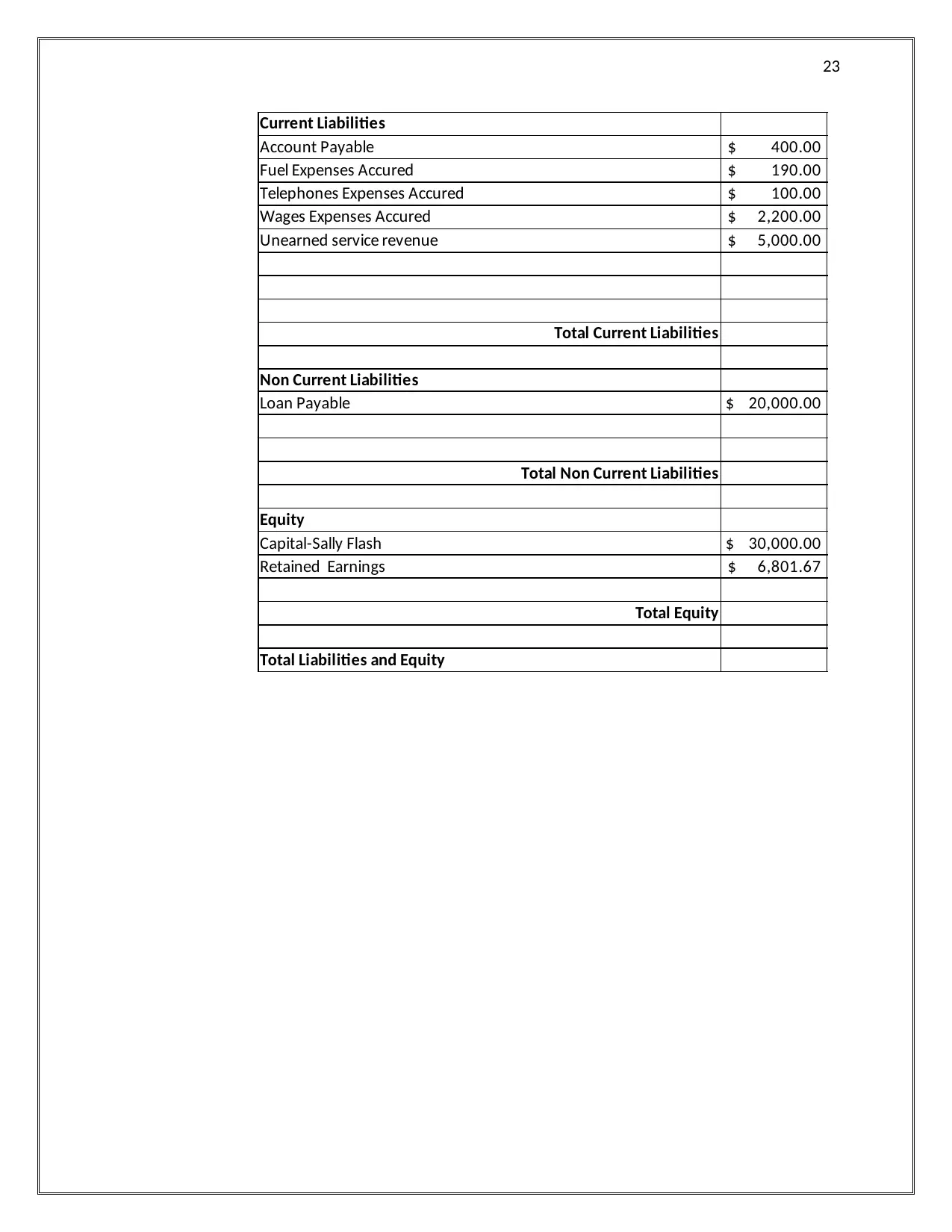
23
Current Liabilities
Account Payable $ 400.00
Fuel Expenses Accured $ 190.00
Telephones Expenses Accured $ 100.00
Wages Expenses Accured $ 2,200.00
Unearned service revenue $ 5,000.00
Total Current Liabilities
Non Current Liabilities
Loan Payable $ 20,000.00
Total Non Current Liabilities
Equity
Capital-Sally Flash $ 30,000.00
Retained Earnings $ 6,801.67
Total Equity
Total Liabilities and Equity
Current Liabilities
Account Payable $ 400.00
Fuel Expenses Accured $ 190.00
Telephones Expenses Accured $ 100.00
Wages Expenses Accured $ 2,200.00
Unearned service revenue $ 5,000.00
Total Current Liabilities
Non Current Liabilities
Loan Payable $ 20,000.00
Total Non Current Liabilities
Equity
Capital-Sally Flash $ 30,000.00
Retained Earnings $ 6,801.67
Total Equity
Total Liabilities and Equity
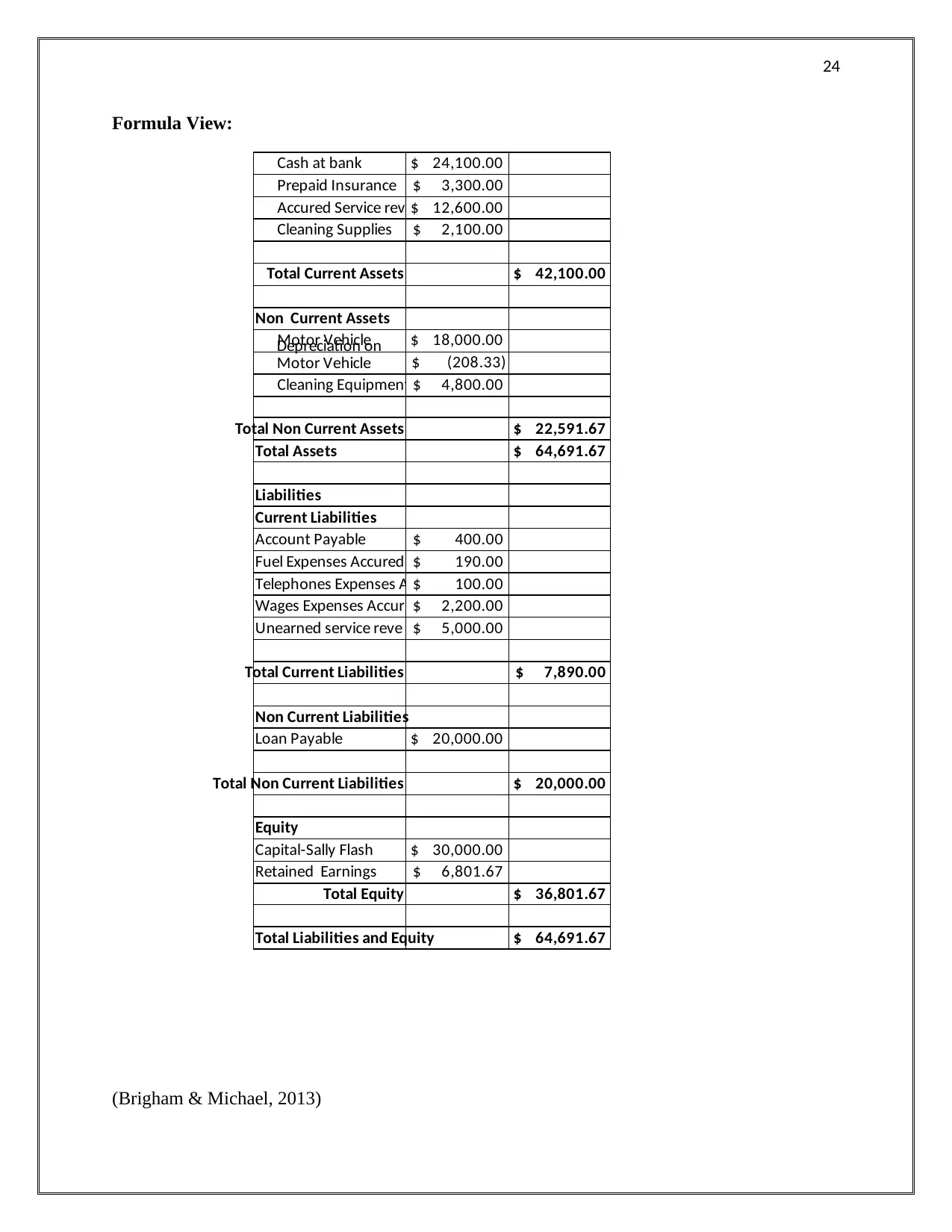
24
Formula View:
Cash at bank $ 24,100.00
Prepaid Insurance $ 3,300.00
Accured Service rev $ 12,600.00
Cleaning Supplies $ 2,100.00
Total Current Assets $ 42,100.00
Non Current Assets
Motor Vehicle $ 18,000.00
$ (208.33)
Cleaning Equipment $ 4,800.00
Total Non Current Assets $ 22,591.67
Total Assets $ 64,691.67
Liabilities
Current Liabilities
Account Payable $ 400.00
Fuel Expenses Accured $ 190.00
Telephones Expenses A $ 100.00
Wages Expenses Accur $ 2,200.00
Unearned service reve $ 5,000.00
Total Current Liabilities $ 7,890.00
Non Current Liabilities
Loan Payable $ 20,000.00
Total Non Current Liabilities $ 20,000.00
Equity
Capital-Sally Flash $ 30,000.00
Retained Earnings $ 6,801.67
Total Equity $ 36,801.67
Total Liabilities and Equity $ 64,691.67
Depreciation on
Motor Vehicle
(Brigham & Michael, 2013)
Formula View:
Cash at bank $ 24,100.00
Prepaid Insurance $ 3,300.00
Accured Service rev $ 12,600.00
Cleaning Supplies $ 2,100.00
Total Current Assets $ 42,100.00
Non Current Assets
Motor Vehicle $ 18,000.00
$ (208.33)
Cleaning Equipment $ 4,800.00
Total Non Current Assets $ 22,591.67
Total Assets $ 64,691.67
Liabilities
Current Liabilities
Account Payable $ 400.00
Fuel Expenses Accured $ 190.00
Telephones Expenses A $ 100.00
Wages Expenses Accur $ 2,200.00
Unearned service reve $ 5,000.00
Total Current Liabilities $ 7,890.00
Non Current Liabilities
Loan Payable $ 20,000.00
Total Non Current Liabilities $ 20,000.00
Equity
Capital-Sally Flash $ 30,000.00
Retained Earnings $ 6,801.67
Total Equity $ 36,801.67
Total Liabilities and Equity $ 64,691.67
Depreciation on
Motor Vehicle
(Brigham & Michael, 2013)
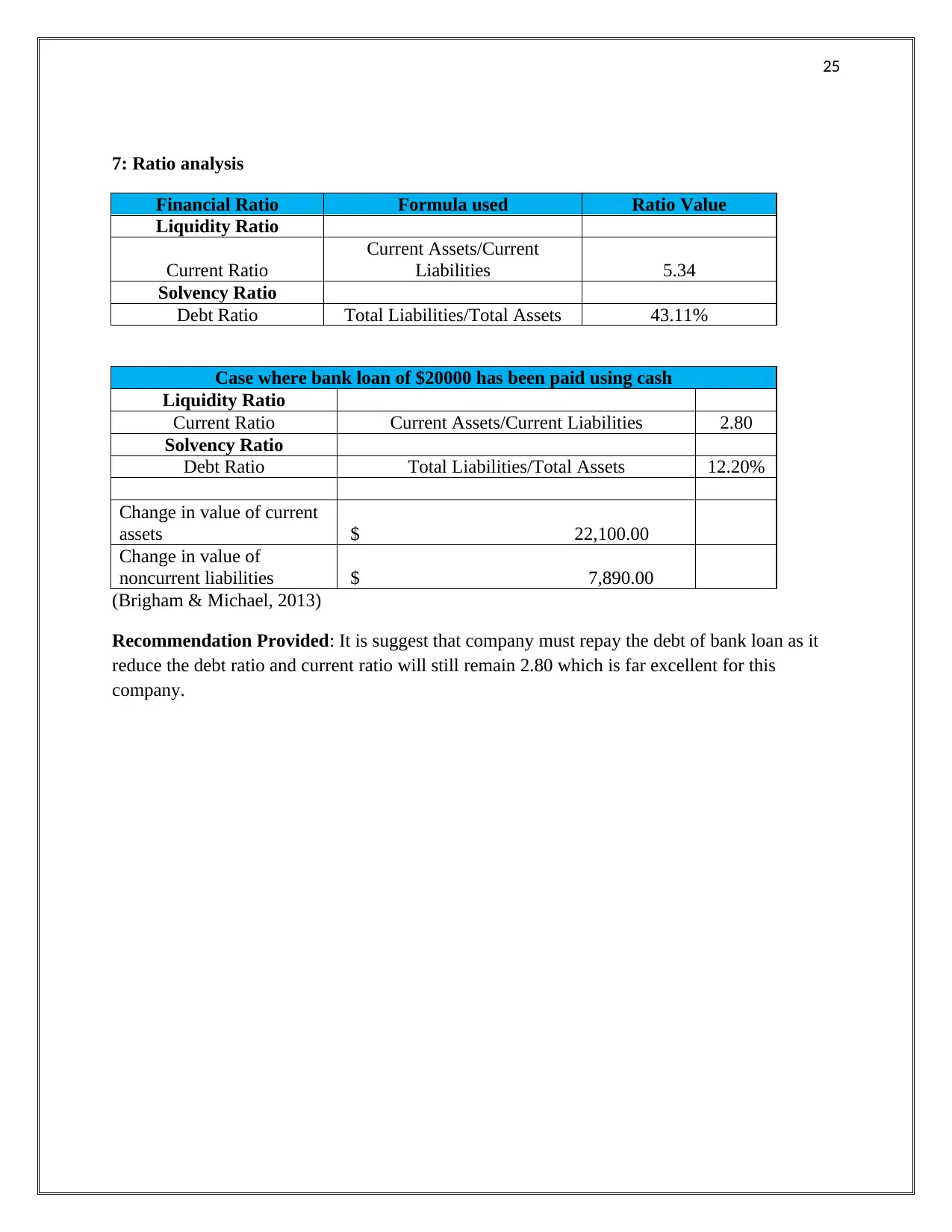
25
7: Ratio analysis
Financial Ratio Formula used Ratio Value
Liquidity Ratio
Current Ratio
Current Assets/Current
Liabilities 5.34
Solvency Ratio
Debt Ratio Total Liabilities/Total Assets 43.11%
Case where bank loan of $20000 has been paid using cash
Liquidity Ratio
Current Ratio Current Assets/Current Liabilities 2.80
Solvency Ratio
Debt Ratio Total Liabilities/Total Assets 12.20%
Change in value of current
assets $ 22,100.00
Change in value of
noncurrent liabilities $ 7,890.00
(Brigham & Michael, 2013)
Recommendation Provided: It is suggest that company must repay the debt of bank loan as it
reduce the debt ratio and current ratio will still remain 2.80 which is far excellent for this
company.
7: Ratio analysis
Financial Ratio Formula used Ratio Value
Liquidity Ratio
Current Ratio
Current Assets/Current
Liabilities 5.34
Solvency Ratio
Debt Ratio Total Liabilities/Total Assets 43.11%
Case where bank loan of $20000 has been paid using cash
Liquidity Ratio
Current Ratio Current Assets/Current Liabilities 2.80
Solvency Ratio
Debt Ratio Total Liabilities/Total Assets 12.20%
Change in value of current
assets $ 22,100.00
Change in value of
noncurrent liabilities $ 7,890.00
(Brigham & Michael, 2013)
Recommendation Provided: It is suggest that company must repay the debt of bank loan as it
reduce the debt ratio and current ratio will still remain 2.80 which is far excellent for this
company.
Paraphrase This Document
Need a fresh take? Get an instant paraphrase of this document with our AI Paraphraser
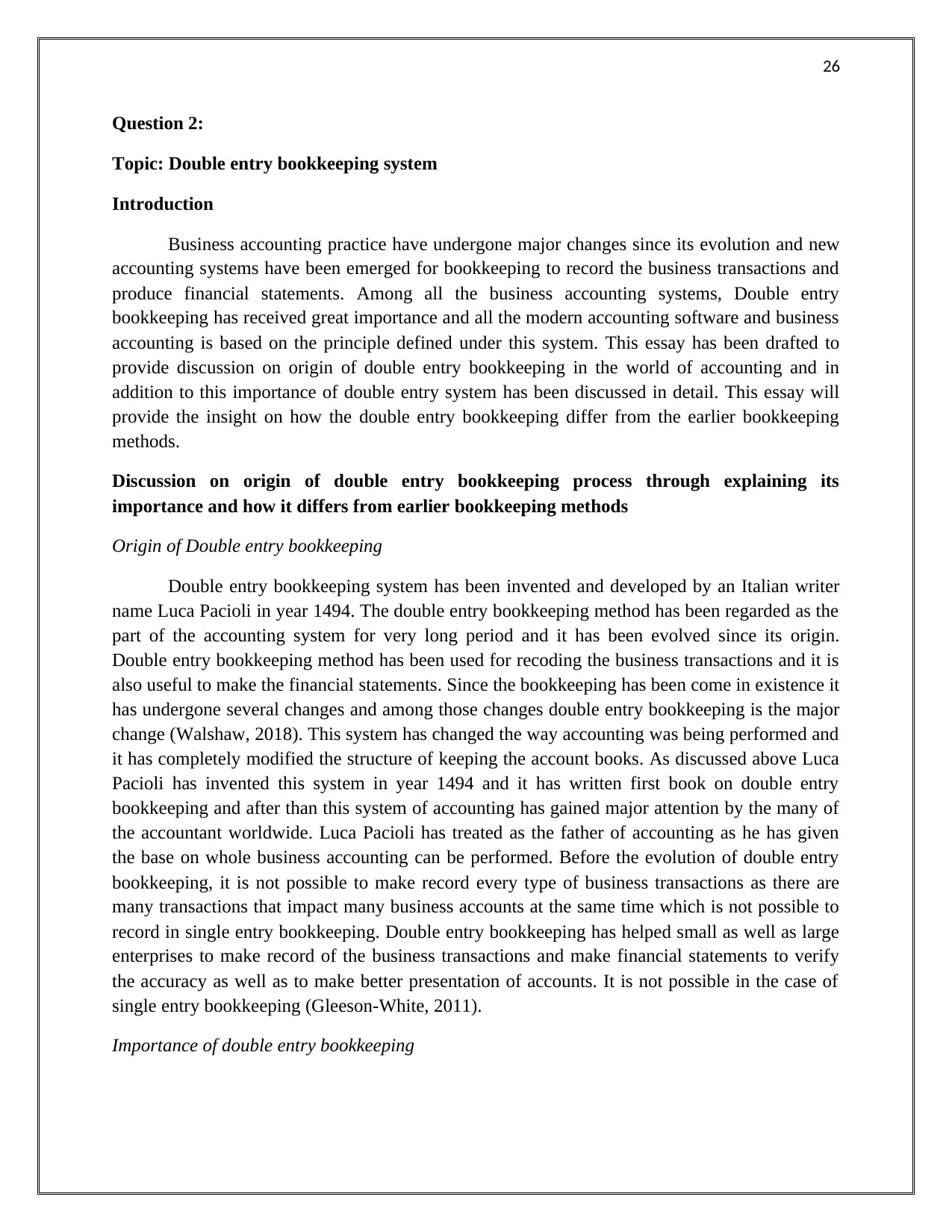
26
Question 2:
Topic: Double entry bookkeeping system
Introduction
Business accounting practice have undergone major changes since its evolution and new
accounting systems have been emerged for bookkeeping to record the business transactions and
produce financial statements. Among all the business accounting systems, Double entry
bookkeeping has received great importance and all the modern accounting software and business
accounting is based on the principle defined under this system. This essay has been drafted to
provide discussion on origin of double entry bookkeeping in the world of accounting and in
addition to this importance of double entry system has been discussed in detail. This essay will
provide the insight on how the double entry bookkeeping differ from the earlier bookkeeping
methods.
Discussion on origin of double entry bookkeeping process through explaining its
importance and how it differs from earlier bookkeeping methods
Origin of Double entry bookkeeping
Double entry bookkeeping system has been invented and developed by an Italian writer
name Luca Pacioli in year 1494. The double entry bookkeeping method has been regarded as the
part of the accounting system for very long period and it has been evolved since its origin.
Double entry bookkeeping method has been used for recoding the business transactions and it is
also useful to make the financial statements. Since the bookkeeping has been come in existence it
has undergone several changes and among those changes double entry bookkeeping is the major
change (Walshaw, 2018). This system has changed the way accounting was being performed and
it has completely modified the structure of keeping the account books. As discussed above Luca
Pacioli has invented this system in year 1494 and it has written first book on double entry
bookkeeping and after than this system of accounting has gained major attention by the many of
the accountant worldwide. Luca Pacioli has treated as the father of accounting as he has given
the base on whole business accounting can be performed. Before the evolution of double entry
bookkeeping, it is not possible to make record every type of business transactions as there are
many transactions that impact many business accounts at the same time which is not possible to
record in single entry bookkeeping. Double entry bookkeeping has helped small as well as large
enterprises to make record of the business transactions and make financial statements to verify
the accuracy as well as to make better presentation of accounts. It is not possible in the case of
single entry bookkeeping (Gleeson-White, 2011).
Importance of double entry bookkeeping
Question 2:
Topic: Double entry bookkeeping system
Introduction
Business accounting practice have undergone major changes since its evolution and new
accounting systems have been emerged for bookkeeping to record the business transactions and
produce financial statements. Among all the business accounting systems, Double entry
bookkeeping has received great importance and all the modern accounting software and business
accounting is based on the principle defined under this system. This essay has been drafted to
provide discussion on origin of double entry bookkeeping in the world of accounting and in
addition to this importance of double entry system has been discussed in detail. This essay will
provide the insight on how the double entry bookkeeping differ from the earlier bookkeeping
methods.
Discussion on origin of double entry bookkeeping process through explaining its
importance and how it differs from earlier bookkeeping methods
Origin of Double entry bookkeeping
Double entry bookkeeping system has been invented and developed by an Italian writer
name Luca Pacioli in year 1494. The double entry bookkeeping method has been regarded as the
part of the accounting system for very long period and it has been evolved since its origin.
Double entry bookkeeping method has been used for recoding the business transactions and it is
also useful to make the financial statements. Since the bookkeeping has been come in existence it
has undergone several changes and among those changes double entry bookkeeping is the major
change (Walshaw, 2018). This system has changed the way accounting was being performed and
it has completely modified the structure of keeping the account books. As discussed above Luca
Pacioli has invented this system in year 1494 and it has written first book on double entry
bookkeeping and after than this system of accounting has gained major attention by the many of
the accountant worldwide. Luca Pacioli has treated as the father of accounting as he has given
the base on whole business accounting can be performed. Before the evolution of double entry
bookkeeping, it is not possible to make record every type of business transactions as there are
many transactions that impact many business accounts at the same time which is not possible to
record in single entry bookkeeping. Double entry bookkeeping has helped small as well as large
enterprises to make record of the business transactions and make financial statements to verify
the accuracy as well as to make better presentation of accounts. It is not possible in the case of
single entry bookkeeping (Gleeson-White, 2011).
Importance of double entry bookkeeping
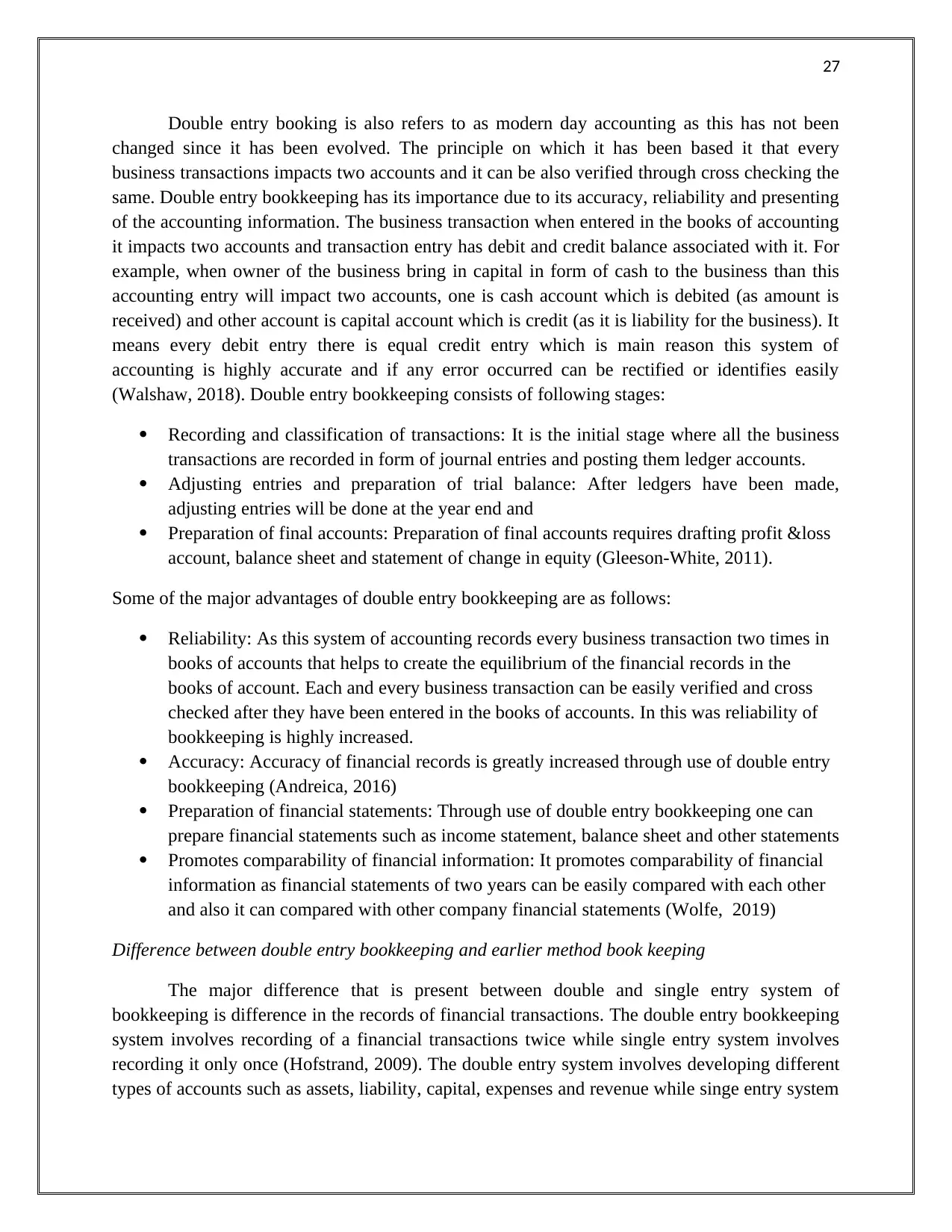
27
Double entry booking is also refers to as modern day accounting as this has not been
changed since it has been evolved. The principle on which it has been based it that every
business transactions impacts two accounts and it can be also verified through cross checking the
same. Double entry bookkeeping has its importance due to its accuracy, reliability and presenting
of the accounting information. The business transaction when entered in the books of accounting
it impacts two accounts and transaction entry has debit and credit balance associated with it. For
example, when owner of the business bring in capital in form of cash to the business than this
accounting entry will impact two accounts, one is cash account which is debited (as amount is
received) and other account is capital account which is credit (as it is liability for the business). It
means every debit entry there is equal credit entry which is main reason this system of
accounting is highly accurate and if any error occurred can be rectified or identifies easily
(Walshaw, 2018). Double entry bookkeeping consists of following stages:
Recording and classification of transactions: It is the initial stage where all the business
transactions are recorded in form of journal entries and posting them ledger accounts.
Adjusting entries and preparation of trial balance: After ledgers have been made,
adjusting entries will be done at the year end and
Preparation of final accounts: Preparation of final accounts requires drafting profit &loss
account, balance sheet and statement of change in equity (Gleeson-White, 2011).
Some of the major advantages of double entry bookkeeping are as follows:
Reliability: As this system of accounting records every business transaction two times in
books of accounts that helps to create the equilibrium of the financial records in the
books of account. Each and every business transaction can be easily verified and cross
checked after they have been entered in the books of accounts. In this was reliability of
bookkeeping is highly increased.
Accuracy: Accuracy of financial records is greatly increased through use of double entry
bookkeeping (Andreica, 2016)
Preparation of financial statements: Through use of double entry bookkeeping one can
prepare financial statements such as income statement, balance sheet and other statements
Promotes comparability of financial information: It promotes comparability of financial
information as financial statements of two years can be easily compared with each other
and also it can compared with other company financial statements (Wolfe, 2019)
Difference between double entry bookkeeping and earlier method book keeping
The major difference that is present between double and single entry system of
bookkeeping is difference in the records of financial transactions. The double entry bookkeeping
system involves recording of a financial transactions twice while single entry system involves
recording it only once (Hofstrand, 2009). The double entry system involves developing different
types of accounts such as assets, liability, capital, expenses and revenue while singe entry system
Double entry booking is also refers to as modern day accounting as this has not been
changed since it has been evolved. The principle on which it has been based it that every
business transactions impacts two accounts and it can be also verified through cross checking the
same. Double entry bookkeeping has its importance due to its accuracy, reliability and presenting
of the accounting information. The business transaction when entered in the books of accounting
it impacts two accounts and transaction entry has debit and credit balance associated with it. For
example, when owner of the business bring in capital in form of cash to the business than this
accounting entry will impact two accounts, one is cash account which is debited (as amount is
received) and other account is capital account which is credit (as it is liability for the business). It
means every debit entry there is equal credit entry which is main reason this system of
accounting is highly accurate and if any error occurred can be rectified or identifies easily
(Walshaw, 2018). Double entry bookkeeping consists of following stages:
Recording and classification of transactions: It is the initial stage where all the business
transactions are recorded in form of journal entries and posting them ledger accounts.
Adjusting entries and preparation of trial balance: After ledgers have been made,
adjusting entries will be done at the year end and
Preparation of final accounts: Preparation of final accounts requires drafting profit &loss
account, balance sheet and statement of change in equity (Gleeson-White, 2011).
Some of the major advantages of double entry bookkeeping are as follows:
Reliability: As this system of accounting records every business transaction two times in
books of accounts that helps to create the equilibrium of the financial records in the
books of account. Each and every business transaction can be easily verified and cross
checked after they have been entered in the books of accounts. In this was reliability of
bookkeeping is highly increased.
Accuracy: Accuracy of financial records is greatly increased through use of double entry
bookkeeping (Andreica, 2016)
Preparation of financial statements: Through use of double entry bookkeeping one can
prepare financial statements such as income statement, balance sheet and other statements
Promotes comparability of financial information: It promotes comparability of financial
information as financial statements of two years can be easily compared with each other
and also it can compared with other company financial statements (Wolfe, 2019)
Difference between double entry bookkeeping and earlier method book keeping
The major difference that is present between double and single entry system of
bookkeeping is difference in the records of financial transactions. The double entry bookkeeping
system involves recording of a financial transactions twice while single entry system involves
recording it only once (Hofstrand, 2009). The double entry system involves developing different
types of accounts such as assets, liability, capital, expenses and revenue while singe entry system
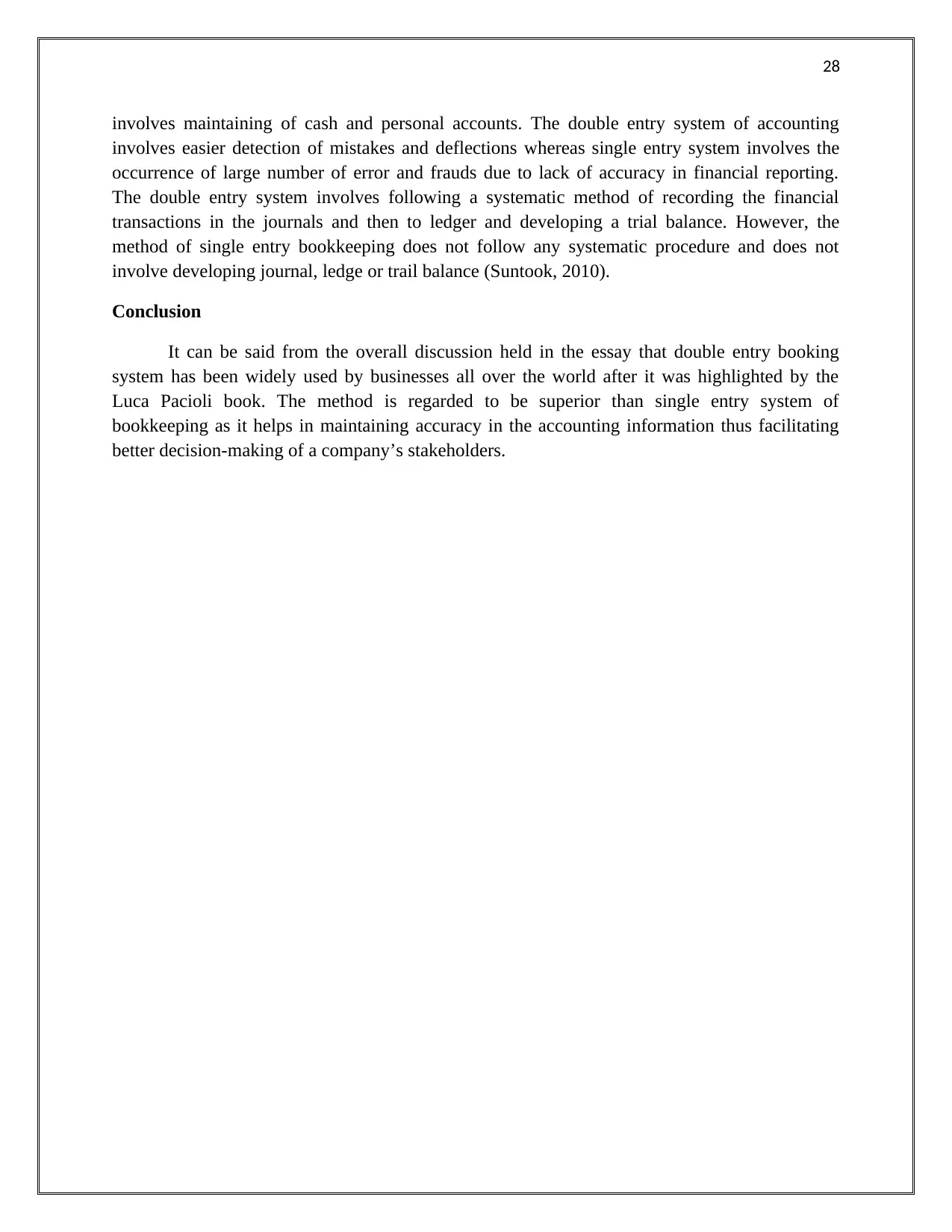
28
involves maintaining of cash and personal accounts. The double entry system of accounting
involves easier detection of mistakes and deflections whereas single entry system involves the
occurrence of large number of error and frauds due to lack of accuracy in financial reporting.
The double entry system involves following a systematic method of recording the financial
transactions in the journals and then to ledger and developing a trial balance. However, the
method of single entry bookkeeping does not follow any systematic procedure and does not
involve developing journal, ledge or trail balance (Suntook, 2010).
Conclusion
It can be said from the overall discussion held in the essay that double entry booking
system has been widely used by businesses all over the world after it was highlighted by the
Luca Pacioli book. The method is regarded to be superior than single entry system of
bookkeeping as it helps in maintaining accuracy in the accounting information thus facilitating
better decision-making of a company’s stakeholders.
involves maintaining of cash and personal accounts. The double entry system of accounting
involves easier detection of mistakes and deflections whereas single entry system involves the
occurrence of large number of error and frauds due to lack of accuracy in financial reporting.
The double entry system involves following a systematic method of recording the financial
transactions in the journals and then to ledger and developing a trial balance. However, the
method of single entry bookkeeping does not follow any systematic procedure and does not
involve developing journal, ledge or trail balance (Suntook, 2010).
Conclusion
It can be said from the overall discussion held in the essay that double entry booking
system has been widely used by businesses all over the world after it was highlighted by the
Luca Pacioli book. The method is regarded to be superior than single entry system of
bookkeeping as it helps in maintaining accuracy in the accounting information thus facilitating
better decision-making of a company’s stakeholders.
Secure Best Marks with AI Grader
Need help grading? Try our AI Grader for instant feedback on your assignments.
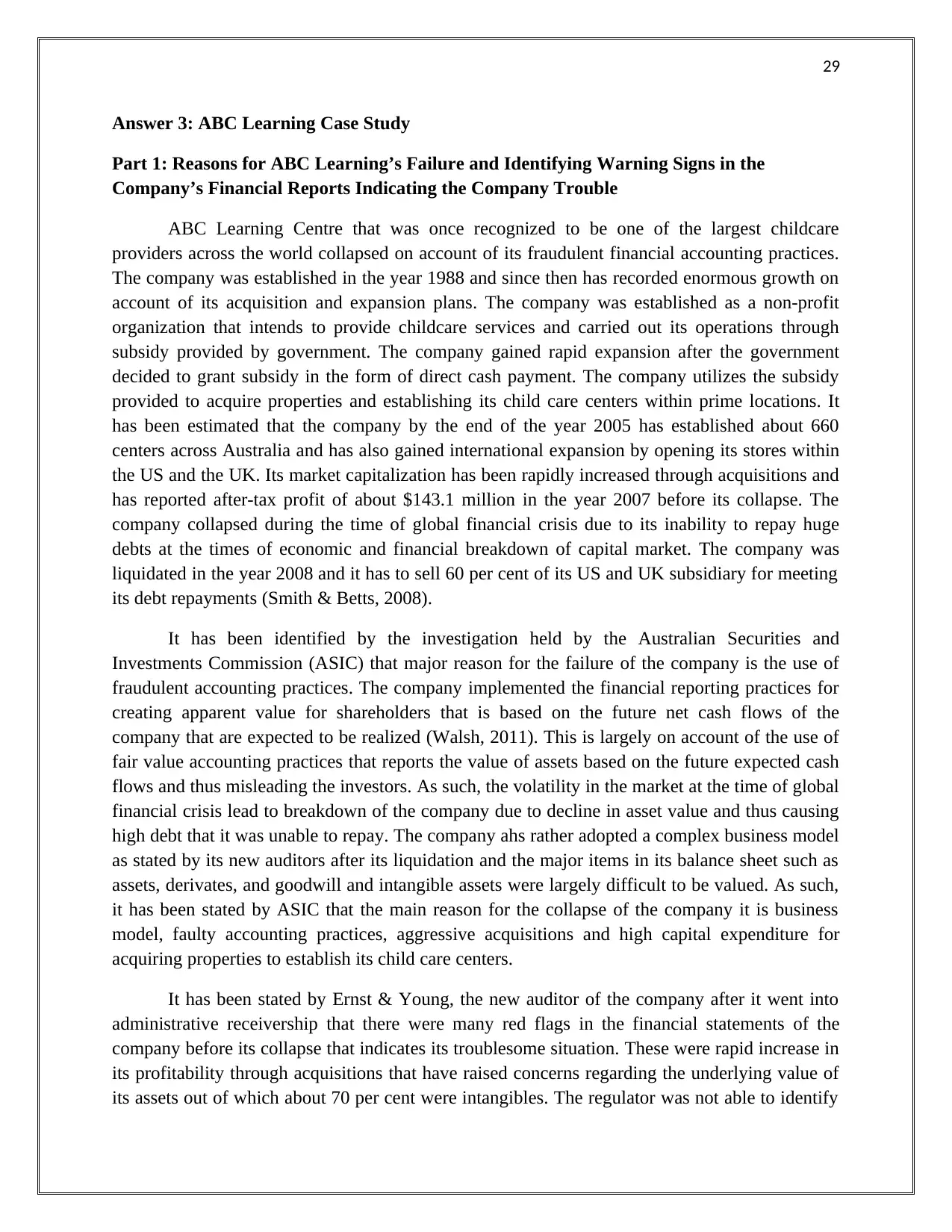
29
Answer 3: ABC Learning Case Study
Part 1: Reasons for ABC Learning’s Failure and Identifying Warning Signs in the
Company’s Financial Reports Indicating the Company Trouble
ABC Learning Centre that was once recognized to be one of the largest childcare
providers across the world collapsed on account of its fraudulent financial accounting practices.
The company was established in the year 1988 and since then has recorded enormous growth on
account of its acquisition and expansion plans. The company was established as a non-profit
organization that intends to provide childcare services and carried out its operations through
subsidy provided by government. The company gained rapid expansion after the government
decided to grant subsidy in the form of direct cash payment. The company utilizes the subsidy
provided to acquire properties and establishing its child care centers within prime locations. It
has been estimated that the company by the end of the year 2005 has established about 660
centers across Australia and has also gained international expansion by opening its stores within
the US and the UK. Its market capitalization has been rapidly increased through acquisitions and
has reported after-tax profit of about $143.1 million in the year 2007 before its collapse. The
company collapsed during the time of global financial crisis due to its inability to repay huge
debts at the times of economic and financial breakdown of capital market. The company was
liquidated in the year 2008 and it has to sell 60 per cent of its US and UK subsidiary for meeting
its debt repayments (Smith & Betts, 2008).
It has been identified by the investigation held by the Australian Securities and
Investments Commission (ASIC) that major reason for the failure of the company is the use of
fraudulent accounting practices. The company implemented the financial reporting practices for
creating apparent value for shareholders that is based on the future net cash flows of the
company that are expected to be realized (Walsh, 2011). This is largely on account of the use of
fair value accounting practices that reports the value of assets based on the future expected cash
flows and thus misleading the investors. As such, the volatility in the market at the time of global
financial crisis lead to breakdown of the company due to decline in asset value and thus causing
high debt that it was unable to repay. The company ahs rather adopted a complex business model
as stated by its new auditors after its liquidation and the major items in its balance sheet such as
assets, derivates, and goodwill and intangible assets were largely difficult to be valued. As such,
it has been stated by ASIC that the main reason for the collapse of the company it is business
model, faulty accounting practices, aggressive acquisitions and high capital expenditure for
acquiring properties to establish its child care centers.
It has been stated by Ernst & Young, the new auditor of the company after it went into
administrative receivership that there were many red flags in the financial statements of the
company before its collapse that indicates its troublesome situation. These were rapid increase in
its profitability through acquisitions that have raised concerns regarding the underlying value of
its assets out of which about 70 per cent were intangibles. The regulator was not able to identify
Answer 3: ABC Learning Case Study
Part 1: Reasons for ABC Learning’s Failure and Identifying Warning Signs in the
Company’s Financial Reports Indicating the Company Trouble
ABC Learning Centre that was once recognized to be one of the largest childcare
providers across the world collapsed on account of its fraudulent financial accounting practices.
The company was established in the year 1988 and since then has recorded enormous growth on
account of its acquisition and expansion plans. The company was established as a non-profit
organization that intends to provide childcare services and carried out its operations through
subsidy provided by government. The company gained rapid expansion after the government
decided to grant subsidy in the form of direct cash payment. The company utilizes the subsidy
provided to acquire properties and establishing its child care centers within prime locations. It
has been estimated that the company by the end of the year 2005 has established about 660
centers across Australia and has also gained international expansion by opening its stores within
the US and the UK. Its market capitalization has been rapidly increased through acquisitions and
has reported after-tax profit of about $143.1 million in the year 2007 before its collapse. The
company collapsed during the time of global financial crisis due to its inability to repay huge
debts at the times of economic and financial breakdown of capital market. The company was
liquidated in the year 2008 and it has to sell 60 per cent of its US and UK subsidiary for meeting
its debt repayments (Smith & Betts, 2008).
It has been identified by the investigation held by the Australian Securities and
Investments Commission (ASIC) that major reason for the failure of the company is the use of
fraudulent accounting practices. The company implemented the financial reporting practices for
creating apparent value for shareholders that is based on the future net cash flows of the
company that are expected to be realized (Walsh, 2011). This is largely on account of the use of
fair value accounting practices that reports the value of assets based on the future expected cash
flows and thus misleading the investors. As such, the volatility in the market at the time of global
financial crisis lead to breakdown of the company due to decline in asset value and thus causing
high debt that it was unable to repay. The company ahs rather adopted a complex business model
as stated by its new auditors after its liquidation and the major items in its balance sheet such as
assets, derivates, and goodwill and intangible assets were largely difficult to be valued. As such,
it has been stated by ASIC that the main reason for the collapse of the company it is business
model, faulty accounting practices, aggressive acquisitions and high capital expenditure for
acquiring properties to establish its child care centers.
It has been stated by Ernst & Young, the new auditor of the company after it went into
administrative receivership that there were many red flags in the financial statements of the
company before its collapse that indicates its troublesome situation. These were rapid increase in
its profitability through acquisitions that have raised concerns regarding the underlying value of
its assets out of which about 70 per cent were intangibles. The regulator was not able to identify
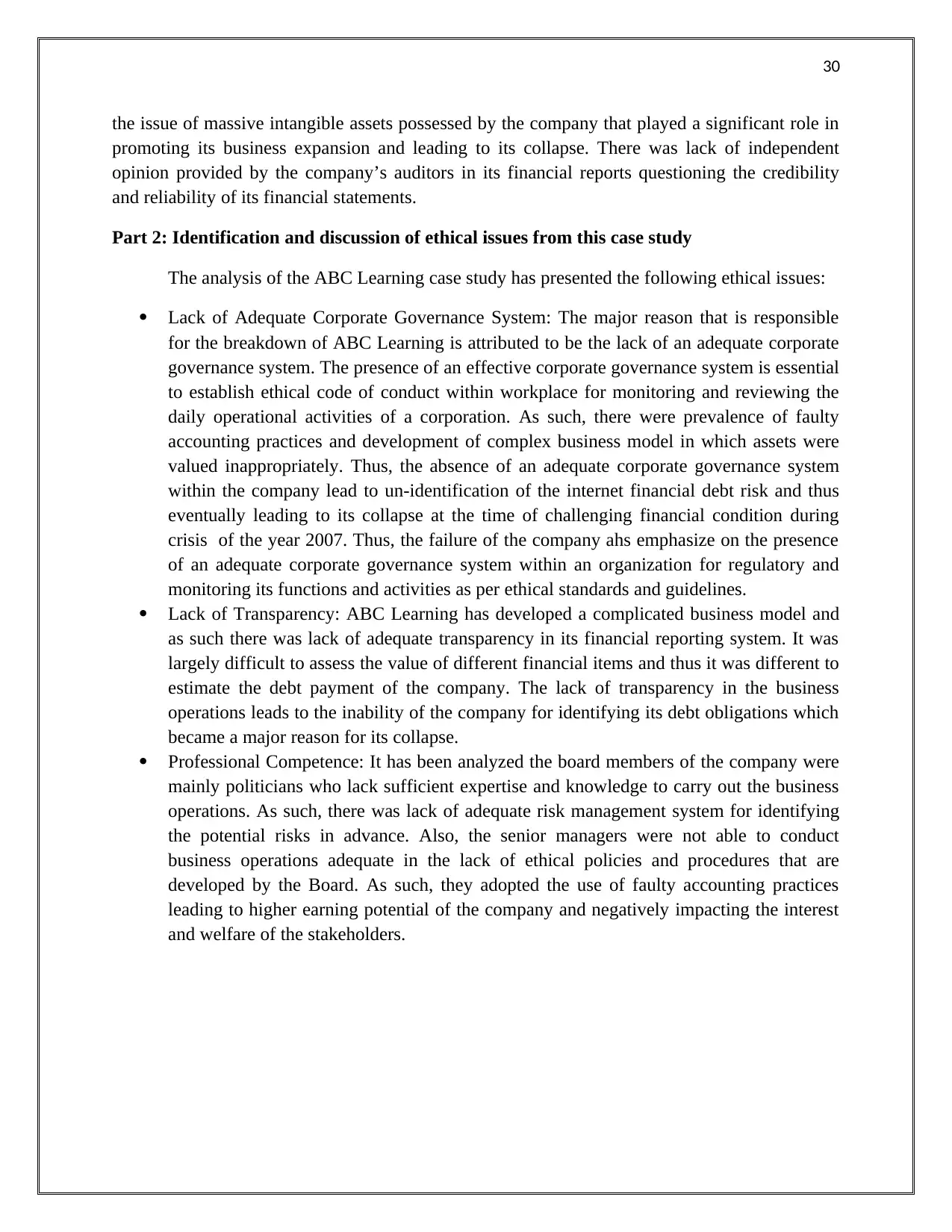
30
the issue of massive intangible assets possessed by the company that played a significant role in
promoting its business expansion and leading to its collapse. There was lack of independent
opinion provided by the company’s auditors in its financial reports questioning the credibility
and reliability of its financial statements.
Part 2: Identification and discussion of ethical issues from this case study
The analysis of the ABC Learning case study has presented the following ethical issues:
Lack of Adequate Corporate Governance System: The major reason that is responsible
for the breakdown of ABC Learning is attributed to be the lack of an adequate corporate
governance system. The presence of an effective corporate governance system is essential
to establish ethical code of conduct within workplace for monitoring and reviewing the
daily operational activities of a corporation. As such, there were prevalence of faulty
accounting practices and development of complex business model in which assets were
valued inappropriately. Thus, the absence of an adequate corporate governance system
within the company lead to un-identification of the internet financial debt risk and thus
eventually leading to its collapse at the time of challenging financial condition during
crisis of the year 2007. Thus, the failure of the company ahs emphasize on the presence
of an adequate corporate governance system within an organization for regulatory and
monitoring its functions and activities as per ethical standards and guidelines.
Lack of Transparency: ABC Learning has developed a complicated business model and
as such there was lack of adequate transparency in its financial reporting system. It was
largely difficult to assess the value of different financial items and thus it was different to
estimate the debt payment of the company. The lack of transparency in the business
operations leads to the inability of the company for identifying its debt obligations which
became a major reason for its collapse.
Professional Competence: It has been analyzed the board members of the company were
mainly politicians who lack sufficient expertise and knowledge to carry out the business
operations. As such, there was lack of adequate risk management system for identifying
the potential risks in advance. Also, the senior managers were not able to conduct
business operations adequate in the lack of ethical policies and procedures that are
developed by the Board. As such, they adopted the use of faulty accounting practices
leading to higher earning potential of the company and negatively impacting the interest
and welfare of the stakeholders.
the issue of massive intangible assets possessed by the company that played a significant role in
promoting its business expansion and leading to its collapse. There was lack of independent
opinion provided by the company’s auditors in its financial reports questioning the credibility
and reliability of its financial statements.
Part 2: Identification and discussion of ethical issues from this case study
The analysis of the ABC Learning case study has presented the following ethical issues:
Lack of Adequate Corporate Governance System: The major reason that is responsible
for the breakdown of ABC Learning is attributed to be the lack of an adequate corporate
governance system. The presence of an effective corporate governance system is essential
to establish ethical code of conduct within workplace for monitoring and reviewing the
daily operational activities of a corporation. As such, there were prevalence of faulty
accounting practices and development of complex business model in which assets were
valued inappropriately. Thus, the absence of an adequate corporate governance system
within the company lead to un-identification of the internet financial debt risk and thus
eventually leading to its collapse at the time of challenging financial condition during
crisis of the year 2007. Thus, the failure of the company ahs emphasize on the presence
of an adequate corporate governance system within an organization for regulatory and
monitoring its functions and activities as per ethical standards and guidelines.
Lack of Transparency: ABC Learning has developed a complicated business model and
as such there was lack of adequate transparency in its financial reporting system. It was
largely difficult to assess the value of different financial items and thus it was different to
estimate the debt payment of the company. The lack of transparency in the business
operations leads to the inability of the company for identifying its debt obligations which
became a major reason for its collapse.
Professional Competence: It has been analyzed the board members of the company were
mainly politicians who lack sufficient expertise and knowledge to carry out the business
operations. As such, there was lack of adequate risk management system for identifying
the potential risks in advance. Also, the senior managers were not able to conduct
business operations adequate in the lack of ethical policies and procedures that are
developed by the Board. As such, they adopted the use of faulty accounting practices
leading to higher earning potential of the company and negatively impacting the interest
and welfare of the stakeholders.
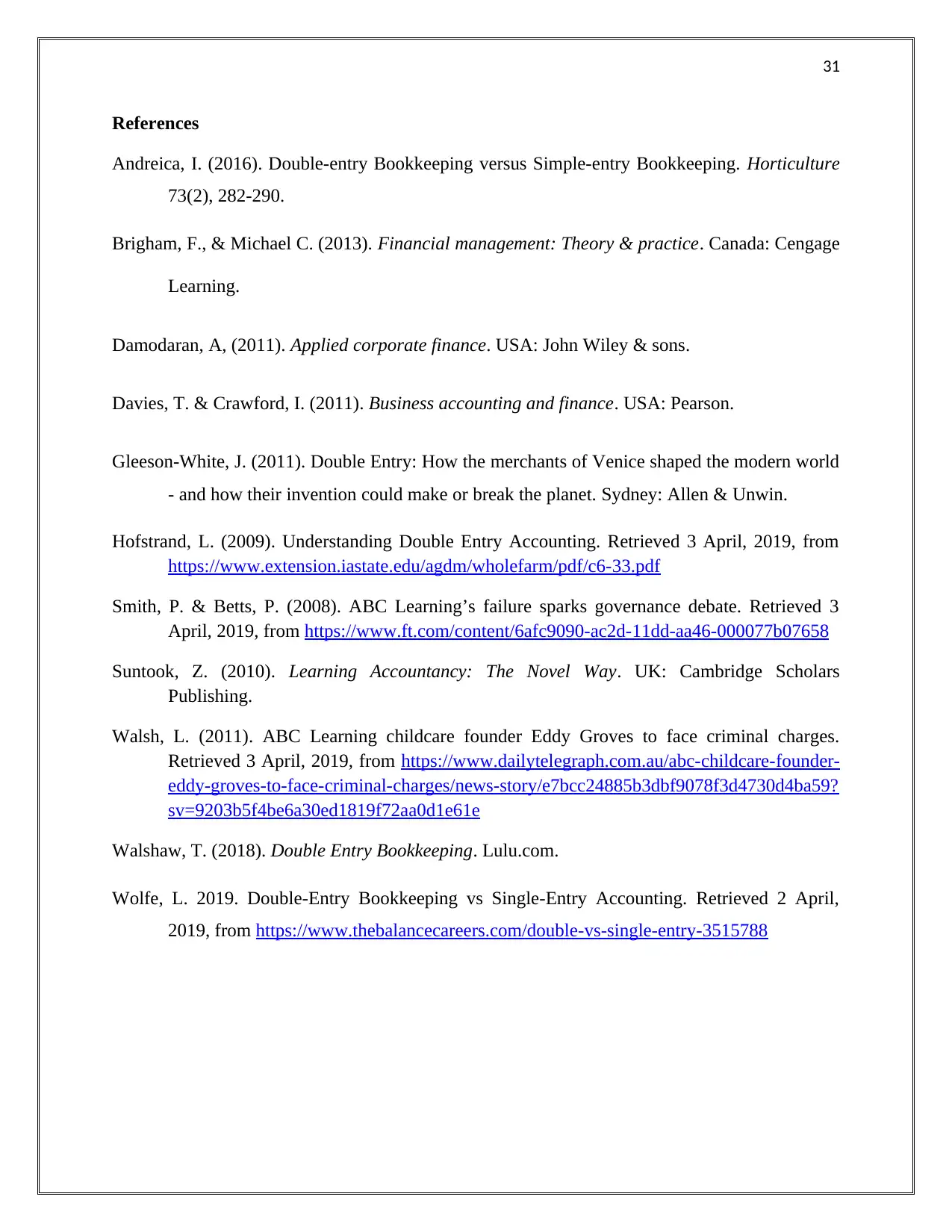
31
References
Andreica, I. (2016). Double-entry Bookkeeping versus Simple-entry Bookkeeping. Horticulture
73(2), 282-290.
Brigham, F., & Michael C. (2013). Financial management: Theory & practice. Canada: Cengage
Learning.
Damodaran, A, (2011). Applied corporate finance. USA: John Wiley & sons.
Davies, T. & Crawford, I. (2011). Business accounting and finance. USA: Pearson.
Gleeson-White, J. (2011). Double Entry: How the merchants of Venice shaped the modern world
- and how their invention could make or break the planet. Sydney: Allen & Unwin.
Hofstrand, L. (2009). Understanding Double Entry Accounting. Retrieved 3 April, 2019, from
https://www.extension.iastate.edu/agdm/wholefarm/pdf/c6-33.pdf
Smith, P. & Betts, P. (2008). ABC Learning’s failure sparks governance debate. Retrieved 3
April, 2019, from https://www.ft.com/content/6afc9090-ac2d-11dd-aa46-000077b07658
Suntook, Z. (2010). Learning Accountancy: The Novel Way. UK: Cambridge Scholars
Publishing.
Walsh, L. (2011). ABC Learning childcare founder Eddy Groves to face criminal charges.
Retrieved 3 April, 2019, from https://www.dailytelegraph.com.au/abc-childcare-founder-
eddy-groves-to-face-criminal-charges/news-story/e7bcc24885b3dbf9078f3d4730d4ba59?
sv=9203b5f4be6a30ed1819f72aa0d1e61e
Walshaw, T. (2018). Double Entry Bookkeeping. Lulu.com.
Wolfe, L. 2019. Double-Entry Bookkeeping vs Single-Entry Accounting. Retrieved 2 April,
2019, from https://www.thebalancecareers.com/double-vs-single-entry-3515788
References
Andreica, I. (2016). Double-entry Bookkeeping versus Simple-entry Bookkeeping. Horticulture
73(2), 282-290.
Brigham, F., & Michael C. (2013). Financial management: Theory & practice. Canada: Cengage
Learning.
Damodaran, A, (2011). Applied corporate finance. USA: John Wiley & sons.
Davies, T. & Crawford, I. (2011). Business accounting and finance. USA: Pearson.
Gleeson-White, J. (2011). Double Entry: How the merchants of Venice shaped the modern world
- and how their invention could make or break the planet. Sydney: Allen & Unwin.
Hofstrand, L. (2009). Understanding Double Entry Accounting. Retrieved 3 April, 2019, from
https://www.extension.iastate.edu/agdm/wholefarm/pdf/c6-33.pdf
Smith, P. & Betts, P. (2008). ABC Learning’s failure sparks governance debate. Retrieved 3
April, 2019, from https://www.ft.com/content/6afc9090-ac2d-11dd-aa46-000077b07658
Suntook, Z. (2010). Learning Accountancy: The Novel Way. UK: Cambridge Scholars
Publishing.
Walsh, L. (2011). ABC Learning childcare founder Eddy Groves to face criminal charges.
Retrieved 3 April, 2019, from https://www.dailytelegraph.com.au/abc-childcare-founder-
eddy-groves-to-face-criminal-charges/news-story/e7bcc24885b3dbf9078f3d4730d4ba59?
sv=9203b5f4be6a30ed1819f72aa0d1e61e
Walshaw, T. (2018). Double Entry Bookkeeping. Lulu.com.
Wolfe, L. 2019. Double-Entry Bookkeeping vs Single-Entry Accounting. Retrieved 2 April,
2019, from https://www.thebalancecareers.com/double-vs-single-entry-3515788
1 out of 31
Related Documents
Your All-in-One AI-Powered Toolkit for Academic Success.
+13062052269
info@desklib.com
Available 24*7 on WhatsApp / Email
![[object Object]](/_next/static/media/star-bottom.7253800d.svg)
Unlock your academic potential
© 2024 | Zucol Services PVT LTD | All rights reserved.




